The long prelude to THE LONG HALLOWEEN: Jeph Loeb and Tim Sale's Early Collaborations (Part 1 of 2)
While working on my first review for the epic review of Batman: The Long Halloween that we'll be doing here over the next year or so, I'd wanted to give a quick overview of Jeph Loeb and Tim Sale's earlier work. I primarily wanted to focus on their Haunted Knight trilogy of Halloween specials from Legends of the Dark Knight, as they were all direct precursors to TLH, while also giving nods to a couple other, more obscure collaborations between Loeb and Sale.
So I reread these stories, and I dug around and found some interesting interviews with Loeb which shed some light on his creative process, and thus, in typical long-winded Hefner fashion, these "nods" and "quick overviews" exploded into an incredibly long prologue that deserved to be its own post. I think it's important to look at all five of these early collaborations between Loeb and Sale, with a special focus on Loeb himself and how he writes all these stories with similar (or repeating) themes, motifs, quirks, and bad habits, especially his tendency to reference or outright steal scenes from movies. These traits are all present within TLH, but I believe that they're less obvious when that book is read on its own, whereas they become glaring when compared with his earlier stuff which lay the foundation for TLH is more ways than I can count.
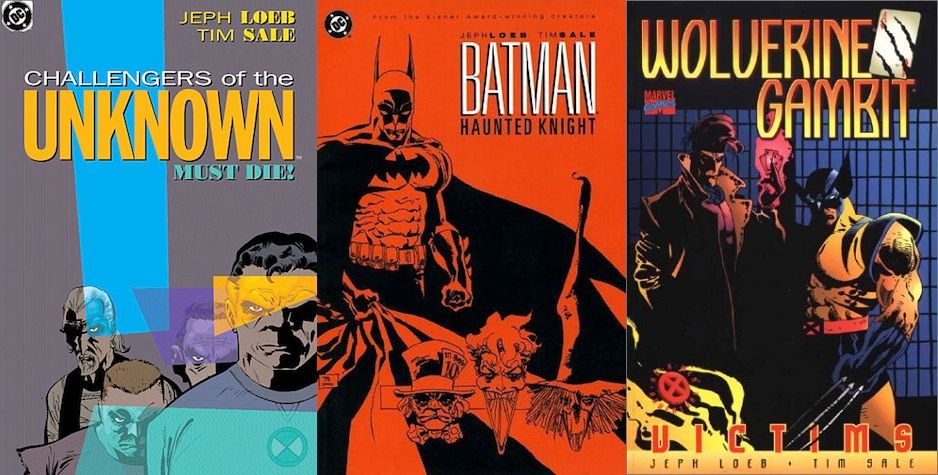
So join me as we examine not only the early collaborations between Loeb and Sale, but also look at Loeb's career and creative process from its humble beginnings way back, even earlier than you expect. Be warned: this post is a bit stream-of-consciousness, but I always manage to get back to the point. Well, almost always.
To get a clue about Loeb's process, we have to go back earlier than his first collaboration with Tim Sale, even before he became a successful Hollywood screenwriter and producer. In Mark Salisbury's 1999 book, Writers on Comics Scriptwriting, Loeb recounted his very first brush with the comics industry. In the early 1970's, back when he was about thirteen years old, a young Joseph Loebs III once wrote a Superman story to try and impress Elliot S! Maggin, one of the great Superman writers of all time. Loeb's story, entitled Why Must There Be a Superman, involved the Guardians of the Universe forcing Clark to account for the fact that his existence is meddling with the outcome of human history, although in Loeb's own words, "it eventually turned into--and I have to cop to this--the end of The Amazing Spider-Man #100." Loeb doesn't elaborate on what that entailed, but I hope it didn't involve a cliffhanger ending where Superman grew extra limbs.
Maggin's response to this story was less than glowing, as he recognized the lift from ASM#100. "I sent it to Elliot and he wrote me this long letter that basically said you can steal from movies, you can steal from books, you can steal from plays, but you can't steal from other comics. Don't do it again." Emphasis in bold is mine, because extra attention should be paid to that quote.
But wait, the story doesn't end there! Not long thereafter, Elliot S! Maggin wrote a story for Superman #247, one that would eventually go on to be considered one of the greatest Superman stories of all time, a tale that featured the Guardians of the Universe putting Superman on trial for crimes against humanity. Can you guess the title of this story?
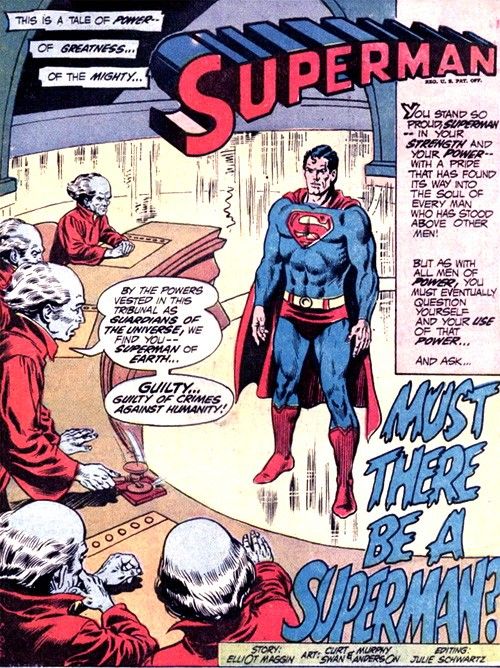
Innnnnnnteresting, eh? Twenty years later, after Maggin had become Loeb's editor and mentor at DC Comics, they went to a comic shop together and found a copy of Superman #247, which is when Loeb casually called out Maggin for ripping off a story that he had condemned for being a rip-off in the first place. "It was like someone had dropped an anvil on his head [when I explained]. For the rest of the day, he just kept apologizing. Ultimately, Elliot's is a different story, because mine was Amazing Spider-Man #100. But I always found it odd that Elliot never mentioned it. So that was really the first comic I ever wrote. Elliot continues to apologize."
What I find interesting about this anecdote is that not only Loeb has been stealing from other stories since the very start of his comics career, but he learned first-hand from Maggin that theft is encouraged and commonplace. This certainly would explain a great deal about how liberally Loeb would "borrow" from other stories throughout his career, not just in Batman: The Long Halloween but all throughout his career as a comic writer who--unlike with "the first comic" he ever wrote--actually gets credited for his own work. Before that happened, though, Loeb realized early on that it's darn near impossible to make a living as a comic writer, so instead he became a Hollywood screenwriter in the 1980's, during which he co-wrote the scripts for four major motion pictures: Teen Wolf with Michael J. Fox, Commando with Arnold Schwarzenegger, Burglar with Whoopi Goldberg, and Teen Wolf Too with Jason Bateman.
You'll note that none of these films are notable for being especially good, but Commando--which Loeb only co-plotted but didn't script--is at least awesomely stupid, and thoroughly entertaining in a very McBain kind of way. So how the heck did Loeb end up writing for comics? The same way anyone gets ahead in both Hollywood and mainstream comics alike: it's all about who you know. A colleague of his who was directing a Superman documentary for TV knew that Loeb was a fanboy and got his pal in touch with DC Comics president Jenette Kahn. Originally, they were going to make a movie of The Flash (it'd be interesting to know how that might have turned out), but when that deal fell through, it looked as though Loeb's association with DC was going to end right then and there. Or it would have, if the Jenette Kahn didn't say, "If you're not going to write a movie for us, would you like to write a comic book?"
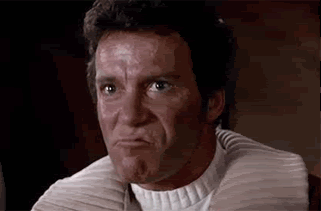
"... KAAAAAAAAHHHHHHHHHNNNNN!!!"
Faced with the prospect of "a dream come true" to write comics for DC, Loeb's mind reeled at the thought of all the stories he wanted to write. In the introduction that accompanied his first published issue, Loeb wrote, "At last, I could get a crack at writing Batman. Or maybe I'd do Superman. Or maybe I'd team up and have them fight Wonder Woman." That last one gives me pause, as I'm not sure if he wanted to have Superman and Batman beat up Wonder Woman together or if he wanted to show how Wonder Woman could kick both Bruce and Clark's combined asses. In any case, I find that interesting considering that Loeb would go on to great success with both Batman and Superman while never writing Wonder Woman in any greater capacity than a supporting role. Hrm.
Unfortunately for Loeb, he wasn't allowed to use either of his two favorites just yet. Working with DC's vice president and executive editor Dick Giordano (who was also probably the greatest Batman inker of all time), Loeb was instead handed a list of available C-list properties, eventually settling on "Challengers of the Unknown, which I didn't really know." A classic Silver Age DC team created by the King himself, Jack Kirby, the Challengers were an adventure-seeking "fantastic foursome" who predated a similar, far more famous Kirby-co-created team by a few years, and Loeb wanted to figure out how to "bring them into the nineties." Oh dear. I dunno about you, but that's an ominously Hollywood-producer-type ambition if ever I've heard one.
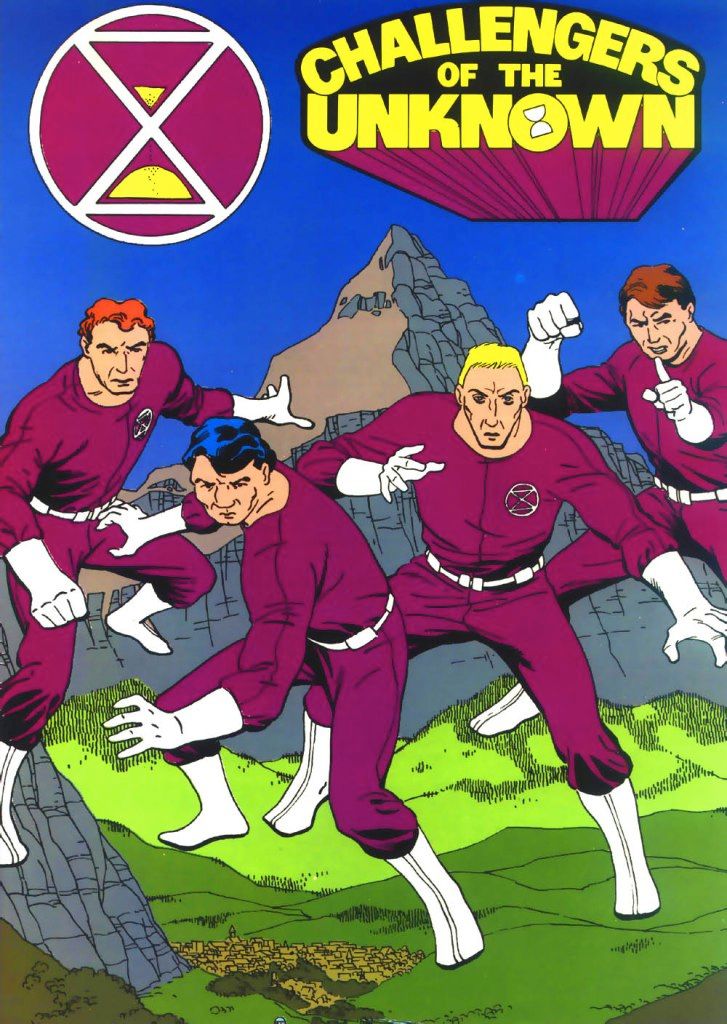
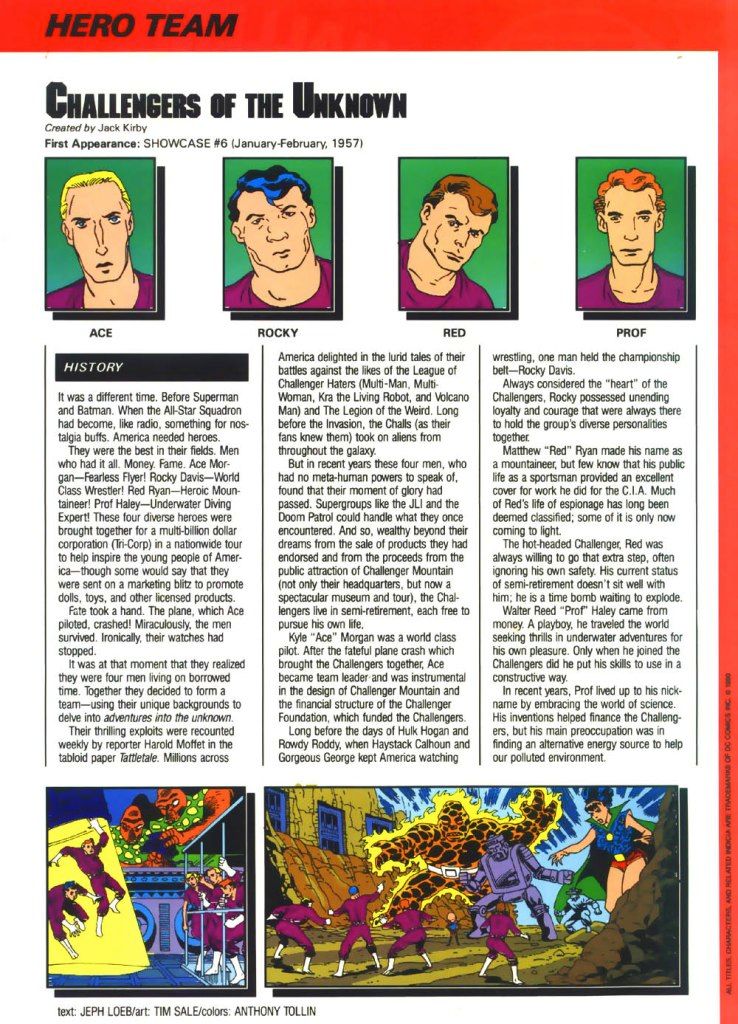
The Challengers' profile Who's Who in the DC Universe #1 (August 1990), written and drawn by the new creative team in anticipation of the series.
When Loeb's editor, Barbara Randall (AKA Barbara Kesel) asked him about potential artists for CotU, Loeb said that he wanted "somebody who can draw guys that look different," and that "The last thing I wanted for the book was to have four men who essentially looked like Bruce Wayne, but with different colored hair." Oddly, Loeb's dream artists to pull this off were "Jim Lee, Whilce Portacio, and Rob Liefeld," none of whom exactly come to mind in terms of making their characters look distinct. As all three were thankfully under contract at Marvel, Randall came up with a very different suggestion: an up-and-comic artist named Tim Sale, who had worked on the indie fantasy anthology Thieves World, plus an issue of Batman where he inked Norm Breyfogle.

I honestly can't tell where the Breyfogle ends and the Sale begins.
Sale was one of those artists who brought a oddball, post-underground-comix sensibility to his work in keeping with other artists of the time, people like Kyle Baker, Marc Hempel, and Matt Wagner (all of whom contributed covers to Loeb and Sale's Challengers of the Unknown, incidentally), as well as Mark Badger, Bernie Mireault, John K. Snyder III, and more. With an art style that resembled a mix between Wagner and Cerebus' Dave Sim, Sale's work was an instant winner with Loeb, who loved how Sale "drew really ugly people," and that "his people looked different. They had hook noses and long necks and some were fat."
Despite this admiration, the partnership between Loeb and Sale was rocky at the start, with Loeb constantly telling Sale to redraw pages to the point where, as Loeb recounted, "We took about a year, and Tim drew probably forty pages for a twenty-two page story before we turned anything in to DC." Eventually, of course, the two clicked and produced a Challengers of the Unknown unlike any other than came before or after. Much like Andrew Helfer's batshit insane run on The Shadow and Grant Morrison's Doom Patrol, this take on CotU was a rather--to put it lightly--irreverent spin on the source material, with the classic characters quickly turning into bizarre, twisted, modern-day versions of themselves. By the time Loeb and Sale were through and the "Challs" received an updated Who's Who entry in February 1992, they were barely recognizable as themselves.
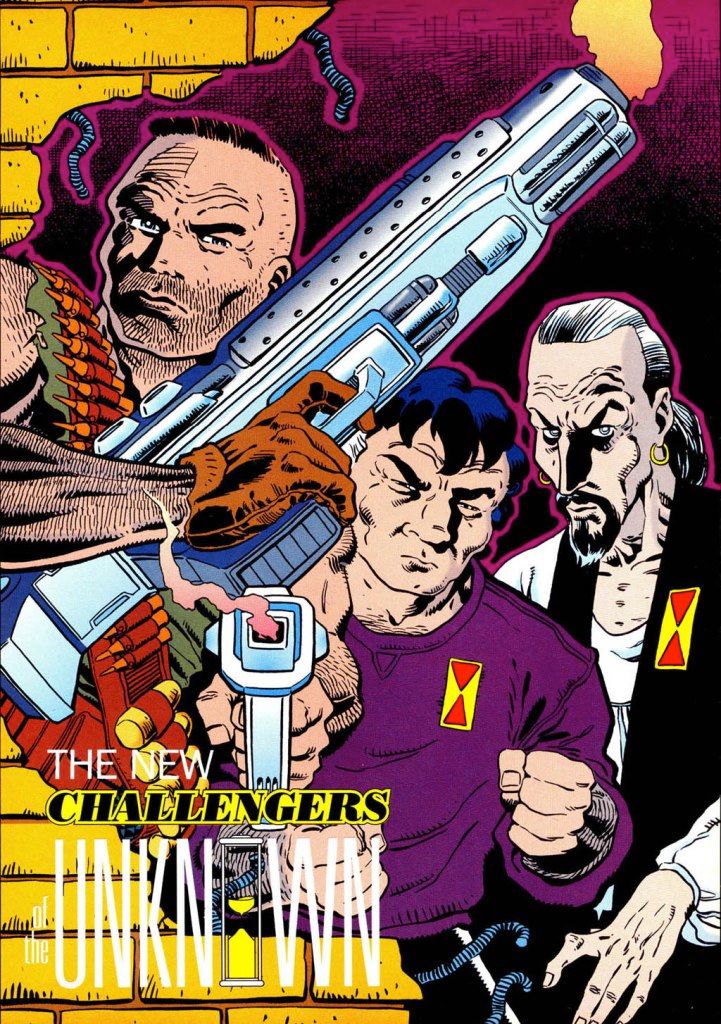
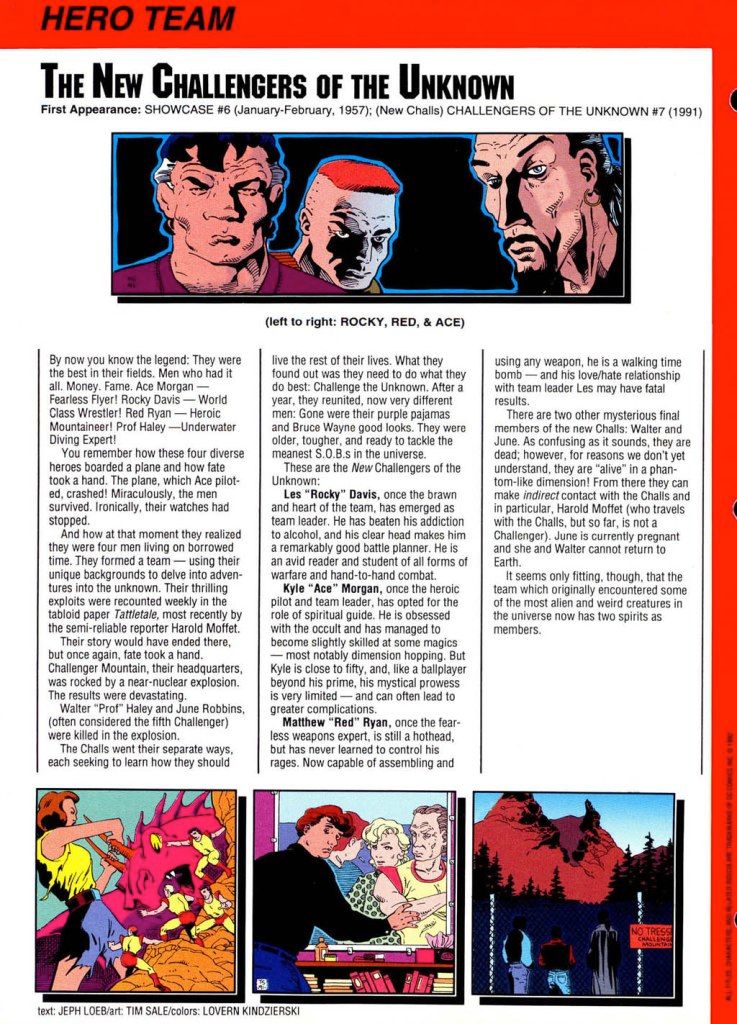
Man, it just screams "EXTREME FOR THE 90'S" doesn't it? To Loeb and Sale's credit, the story is one of their most intriguingly oddball and original works, to the point that it might honestly be their best--or at least, more unique--collaboration, and it wins extra points for featuring the all-star gallery of awesome cover artists. Regardless, it failed to revitalize the team for the modern era, and while the final issue of CotU promised a sequel in the works with Giordano's involvement, those plans were eventually scrapped--I've no idea why--and all subsequent iterations of the CotU apparently ignored Loeb and Sale's take.
This might have spelled the end of Jeph Loeb's comics career, not to mention his partnership with Tim Sale, if it weren't for the intervention of Archie Goodwin, who succeeded Andrew Helfer as editor on Legends of the Dark Knight. I've written in the past about how I thought LotDK went downhill in quality after Helfer's departure, as I feel like the stories under Goodwin were still moody and atmospheric with great art, but the stories themselves weren't as solid as they were under Helfer. As such, Goodwin always struck me as a guy with an eye towards the art aspect of comics over the writing one, but I'm no expert on Goodwin's work, so I could be wrong on that count. What I do know is that Goodwin had a reputation for being the most gosh-darn nice person who ever worked in comics, that he was beloved by everyone, and considering that editors at DC today are such assholes that they're driving away creators in droves, I think everyone could stand to be more like the late Mr. Goodwin.
After bringing Sale onto LotDK with the dark Cavalier story Blades (written by James Robinson), Goodwin discovered that the artist had a knack for drawing both Batman and the landscape of Gotham City, and so, in 1993, he reunited the artist with Loeb to create a story which would change the course of their entire comics career.
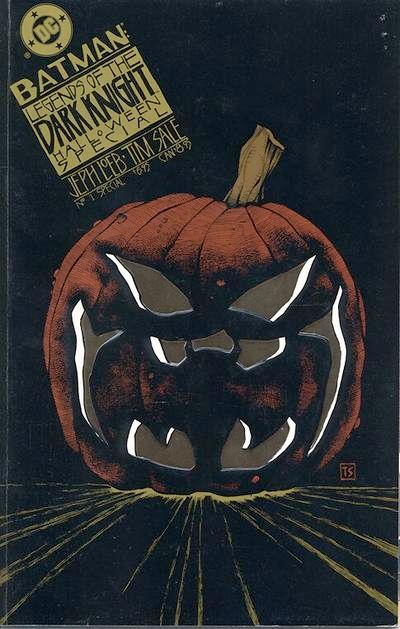
Though he'd originally intended it to be a three-part LotDK story like Blades (and it still reads that way), Loeb was the one who suggested turning the story into a standalone Halloween special. In his introduction for the collected edition of Loeb and Sale's Haunted Knight trilogy (as they came to be known), Goodwin wrote, "Like most great ideas, it seemed simple, obvious, and natural. Amazingly, given Batman's 'creature of the night' persona, no one in recent memory had tried anything quite like it." Strangely, the final story itself actually had very little to do with Halloween besides the fact there's a costume party at Wayne Manor in a scene which looks and feels very reminiscent of an early scene from Matt Wagner's own LotDK story, Faces, and beyond that, there's nothing involving Halloween except... well, it's got the Scarecrow in it, so that counts, somehow?
The title of the special was originally Choices, but it was later changed to punchier Fears by the time it was collected in Batman: Haunted Knight. Though ostensibly a story of Batman facing down the Scarecrow with all the usual beats (Crane terrorizes the city, Batman gets drugged, Batman overcomes it, Batman punches the Scarecrow in the face, yay justice), the heart of the plot involved Bruce finding love with a mysterious woman, who tempts him to hang up his cape and cowl and marry her. So yeah, when the story isn't going through the usual Scarecrow motions, it's focused on the hoary cliche of "superhero finds love, considers giving it up for a normal life, doesn't because of reasons." Obviously, that doesn't work out, and while I won't spoil the not-entirely-surprising twist, I will say that it gives Loeb an opportunity to lift from the ending of the 1981 film Body Heat in the story's final page.
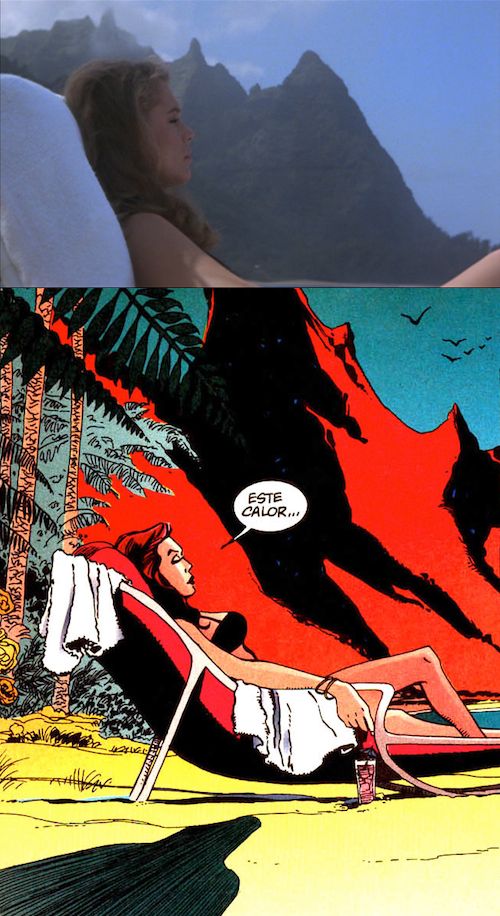
Is this a case of Loeb taking Maggin's "you can steal from movies" to heart, or it just a simple homage? That's a question you'll want to keep in mind, as we'll be asking it a LOT from here on out.
All in all, both plotlines of Fears/Choices are as thin as the paper they're printed on, and that's not even to go into Loeb's use of dialogue and narration, although we will be getting into those in the reviews of TLH. As will be the case for all of the collaborations between Jeph Loeb and Tim Sale, I strongly suspect that the story would have fallen apart without Sale's artwork holding it together. If it's unfair to outright call Sale the true power behind this team, then at the very least, Loeb's greatest skill has been knowing how to utilize Sale's strenghts for maximum impact. I'm tempted to call Sale's work "unlike anything we've ever seen before," when in fact it shares similar characteristics of artists like David Mazzucchelli and Matt Wagner, all whipped up into a style which helped make Fears/Choices a hit and secure a sequel for him and Loeb.
Aside from Sale's storytelling, the most remarkable thing about Fears/Choices is their take on the Scarecrow, which was a wildly different take on the character both in terms of writing and design, the latter of which seems to be directly based on an obscure old Disney show called The Scarecrow of Romney Marsh, also known as Alias, the Scarecrow, which starred The Prisoner's Patrick MacGoohan. Sale's Scarecrow design also added other touches for creepiness' sake, such giving Crane freaky long fingernails for some reason, and a crooked hat that would fit right in with a Tim Burton movie.
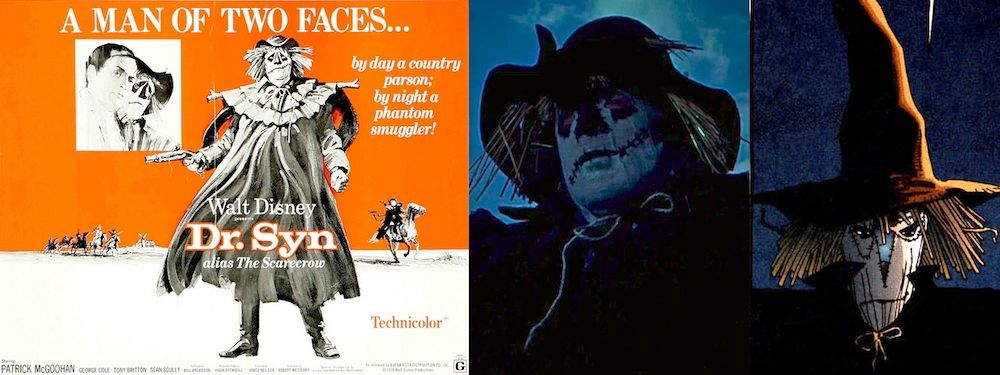
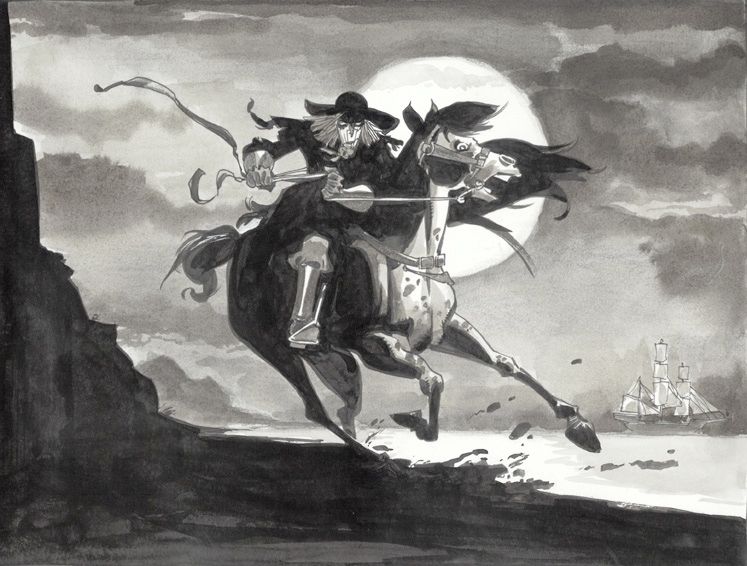
Some fan even went full circle and commissioned a Dr. Syn Scarecrow piece by Sale!
But by far, the weirdest change was Loeb's decision to have the Scarecrow speak almost entirely in lines from nursery rhymes. Why? The Scarecrow has never had any history with nursery rhymes, nor does he have any reason to quote them within the context of the story. I can only suppose that Loeb did this because it's intended to be creepy, regardless of whether or not it makes sense. Now, in one panel, he also quotes the Scarecrow from The Wizard of Oz ("That way is a very nice way. It's pleasant down this way, too. Of course, people do go both ways," he says at one point for no reason), but that's at least marginally relevant to the character, unlike all the goddamn nursery rhymes. This will be far from the last time that Loeb puts mood and atmosphere over plot and consistent characterization.
That said, perhaps the "consistent characterization" part doesn't matter, considering that Legends of the Dark Knight existed in a strange area where the rules of continuity didn't really apply, here's where things start to get kinda murky. If you'll allow me to tangent for a bit, I think it's worth pointing out that the introduction to the first issue of LotDK touted that the new series was intended for creators "to tell stories that stand alone, outside the regular continuity of Batman and Detective Comics." Furthermore, in his intro to Haunted Knight, Archie Goodwin described the gist of LotDK as follows: "Set in the early years of Batman's career, Legends of the Dark Knight story arcs function like self-contained novels or novelettes without the ongoing continuity associated with most comics today."
Does this mean that the stories of LotDK--including Loeb and Sale's, all the way up through The Long Halloween--were intended out of continuity? I certainly took it that way, especially once I saw that Wizard Magazine said that TLH "isn't regarded as true continuity" because it was published under the LotDK banner. On the other hand, a couple of the original LotDK stories were later written into proper ongoing continuity, but both of those stories--Shaman and Venom--were written by Denny O'Neil, who was also group editor of the Batman books, so he's allowed the bend the rules in ways that other writers aren't.
My Henchgirl has guideline for continuity: it's not canon unless the events have been reaffirmed or referenced by at least one other writer. By that rule, Venom is in canon because it was referenced by Doug Moench in Knightfall, but Shaman is not, because the only writer who gave a shit about Shaman was O'Neil himself. Furthermore, LotDK featured other unique takes on Batman characters--including the Cavalier, Catman, the Spook, and Hugo Strange--which weren't reflected in regular continuity, unless/until someone decided to come along later and acknowledge the LotDK version, as Devin Grayson did with Hugo a decade after Prey came out. Goddammit, DC, what do you pay your editors for?! Argh!
As such, I think Loeb and Sale's stories--like all of LotDK--aren't strictly "out of continuity" as much as they are, as Wizard put it, "not true continuity." Basically, they're out of continuity until stated otherwise, and even then, preferably written by some source other than the writer who wrote it in the first place. For example, The Long Halloween and Dark Victory were originally out of continuity because no other stories referenced those events until Batman: Hush in 2003, but that still doesn't really count because it was written by Jeph Loeb. It wasn't until 2009 with Batman #692 that it was finally referenced in a mainstream Batman comic, thus making it canon. Thanks, Tony Daniel! *gold star*
With all that in mind, the Scarecrow's bizarre appearance and propensity for speaking in nursery rhymes can arguably be excused here and enjoyed on its own merits (such as they are) with the understanding that this is purely Loeb and Sale's take, existing within their own sub-universe of Batman stories. In any case, the Scarecrow is a popular and iconic enough character that Loeb and Sale's take--while relatively popular, it seems--hasn't greatly affected the character anywhere else, aside from influencing a line of dialogue in Batman Begins. Whether you love or hate "Salecrow," it hasn't affected the character as a whole. The same, however, cannot be said of the Mad Hatter, who was the star of Loeb and Sale's second LotDK Halloween special, which came out in 1994.
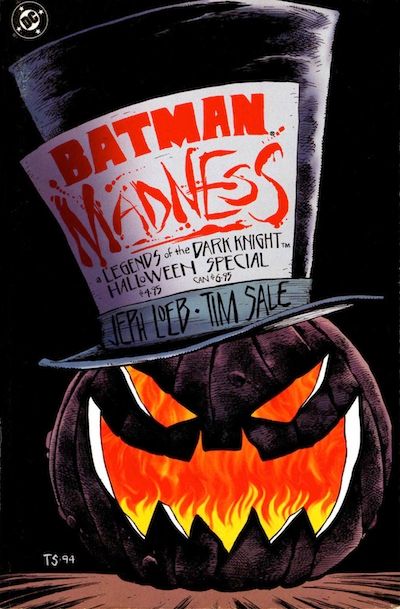
There's a lot to discuss when it comes to Madness beyond its beat-by-beat copycat plotline of Fears/Choices, not the least of which being how it was instrumental in helping to make Jervis Tetch a toxic, unusable character in comics and other media. Of course, we can't put all the blame on Loeb and Sale, because if there's one single creator who's done more damage to Jervis Tetch than anyone else, it's Grant Morrison. In Arkham Asylum: A Serious House on Serious Earth, Morrison redefined the classic C-list Batman villain by writing him in such a way that strongly implied tendencies towards pedophilia, a meta reference to the controversy about Lewis Carroll's own possible pedophilia. Now, this in of itself wasn't so harmful to Jervis, as Arkham Asylum was itself a story very much in the same LotDK vein of being "not true continuity," and sure enough, no hints of pedophilia were included in the Hatter's subsequent appearance in Knightfall, where Doug Moench wrote Jervis the same way that he wrote the character in the 80's.

More importantly, a few months before that issue of Knightfall came out, the Mad Hatter had already been reinvented in Batman: The Animated Series, which remains the very best version of the character. Delightful and disturbing, skeezy yet sympathetic, and perfectly voiced by Roddy McDowall, the TAS Hatter had a personality, motivation, and a distinct appearance that made him unique and recognizable rather than mere evil version of Sir John Tenniel's iconic illustration, which is how the character originally appeared in his Golden Age first appearance. The TAS version by Paul Dini turned the C-list villain into one of the richest rogues in Batman's gallery, leaving it to comics to embrace this take on the Hatter just as they did (or tried to do) with Mister Freeze.
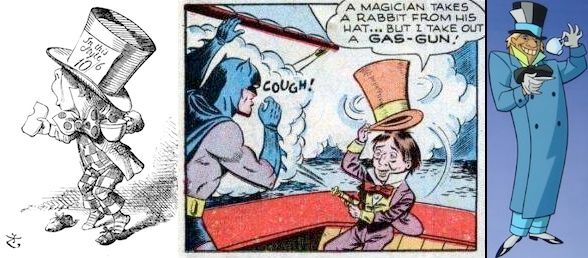
Of course, that never happened, and I think we have Loeb and Sale to blame for that, as their version of the Mad Hatter has proven to be the most influential for the character in comics, games, and animation alike, in terms of both physical appearance and in his motivations as a character. In Madness--and I'll talk about the story as a whole soon after I rant a bit first--the Mad Hatter not only now physically resembled the Tenniel drawing again, but he also took Morrison's implications of pedophilia and put them into practice by having their Hatter kidnap runaway children and keep them in his hideout, where he forces them to drink drugged tea and dress in Wonderland costumes.
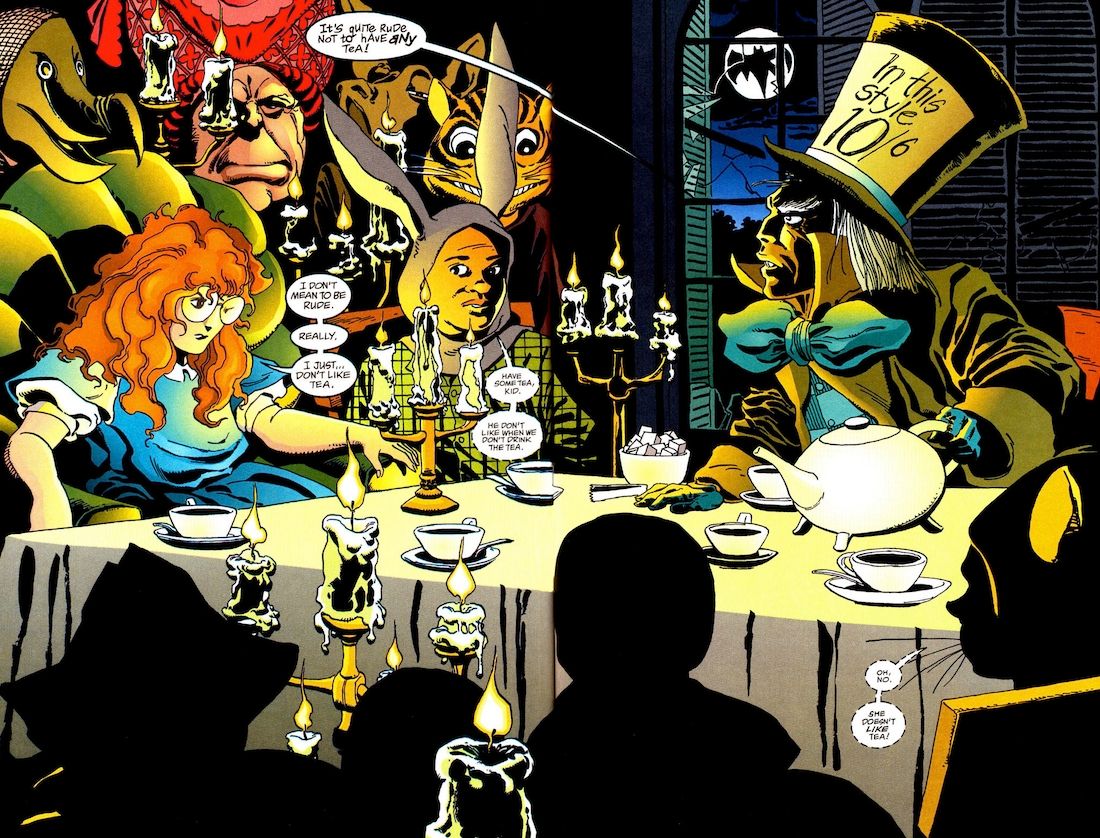
Is it even worth mentioning that this is a recreation of the classic Mad Tea Party scene by Tenniel? Everyone knows that, right? Does that make this clever or just obvious?
Sure, no sexual interest in the children is ever mentioned in Loeb's story, but considering that the Hatter never went after kids before, it's hard not to feel skeezed out by the implications of kidnapping and drugging children for one's own pleasure. Especially considering that Madness doesn't give any reason WHY Jervis is kidnapping children, leaving it entirely to us readers to figure out why. Now, I suppose there's the possibility that there really isn't anything sexual about this, and that maybe he just wants them to live out an eternal childish fantasy at gunpoint, or heck, maybe he could have been giving these runaways sanctuary and protection like Poison Ivy did in No Man's Land. That would have been a great idea, actually!
But no, considering that his hideout in an old mansion where a child was murdered by kidnappers, not to mention the fact that he was gleefully ready to strange a teenage girl at one point, I think it's safe to assume that the subtext, at least, goes back to Morrison's disturbing implications. To make matters worse, Jeph Loeb's Mad Hatter had no personality to go with his lack of motivations, reducing him to a cipher who--you guessed it--speaks only in quotes. Well, at least it's appropriate for the Mad Hatter to speak in Lewis Carroll quotes, so I guess that sorta makes up for him being a poorly-written non-character whose pedophiliac subtext pretty much ruined the character forever.
Ever since Madness, the Mad Hatter has not only physically remained a dwarf who often shares similar costume characteristics to Sale's design (something which even TAS adapted in their redesign of the character for The New Batman Adventures, right down to Madness' color scheme and the fact that he's much older than TAS Jervis), but he's almost always been depicted as a child-like pervert who has been shown to do things like mind-controlling young girls so he could sell them as sex slaves to pedophile diplomat and fuck hats in his free time. His most famous appearance in the past decade has been in a pair of video games where he's explicitly depicted as "a rapist and murderer" who brainwashed women into being his "Alice" and then killing them afterwards. All this can arguably be traced to Jeph Loeb and Tim Sale as much as Grant Morrison himself, which makes it hard for me to try and enjoy Madness on its own merits. Whatever those merits may be. Let's examine it, shall we?
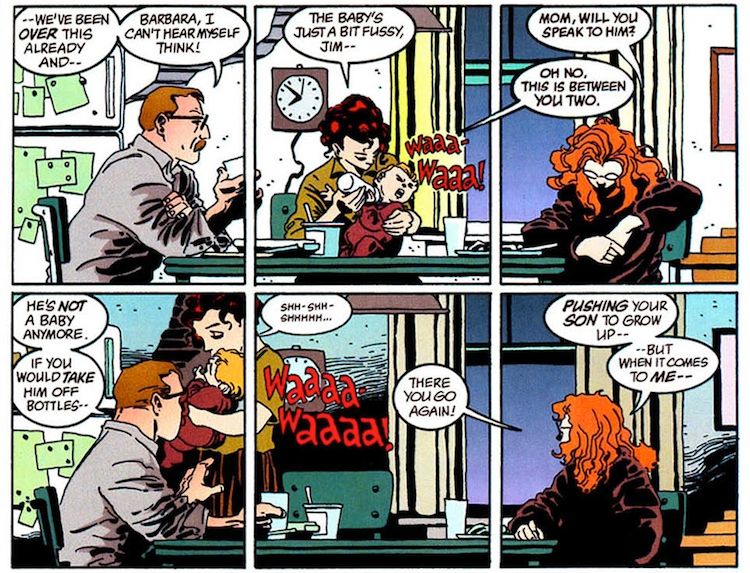
The Gordon Family: James, Barbara, Barbara, and James. Comic writers are an imaginative bunch, aren't they?
While Fears/Choices took place in a nebulous "Year One"-ish period, Madness is set a bit later on in Batman's career. Or maybe earlier. It's hard to tell. James Gordon Jr. was born near the end of Batman: Year One, and he looks about six months old in Madness, although Jim Sr. is shown insisting that "he's not a baby anymore" while trying to get him weaned off bottles, so he could just be a really tiny two-year-old, which could set this in as late as Batman's Year Three period.
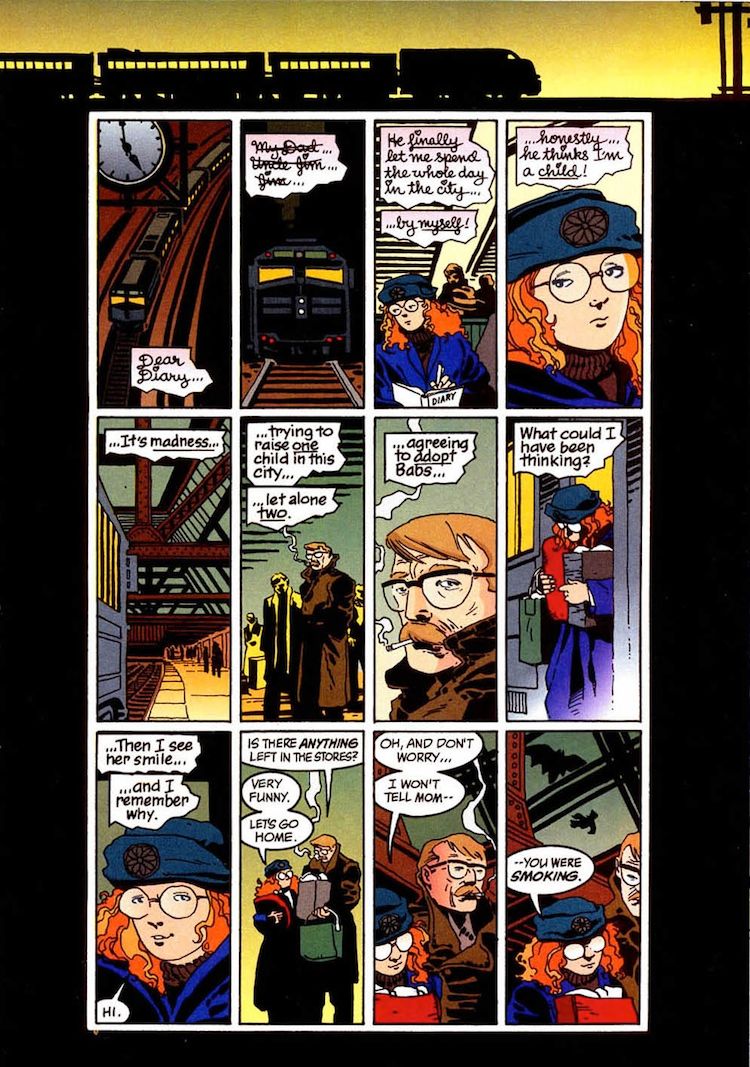
Also, teenage Barbara Gordon is living with James and his wife, also named Barbara, because this is the set in the Post-Crisis period where--in an excellent new origin written by Loeb's CotU editor, Barbara Randall--Babs is Jim's niece whom he adopted after her father, Jim's brother, died of alcohol abuse. Also, Batman mentions Two-Face, so this has to be set after TLH, unless Loeb and Sale didn't bother trying to keep their own continuity straight... you know what, screw it. Let's just accept that it's "not true continuity" and go on from there. We're introduced to Babs--who, as depicted by Sale, has Hermione hair--in a page that strongly resembles the first page of Frank Miller and David Mazzucchelli's Batman: Year One, where we were introduced to Jim Gordon.
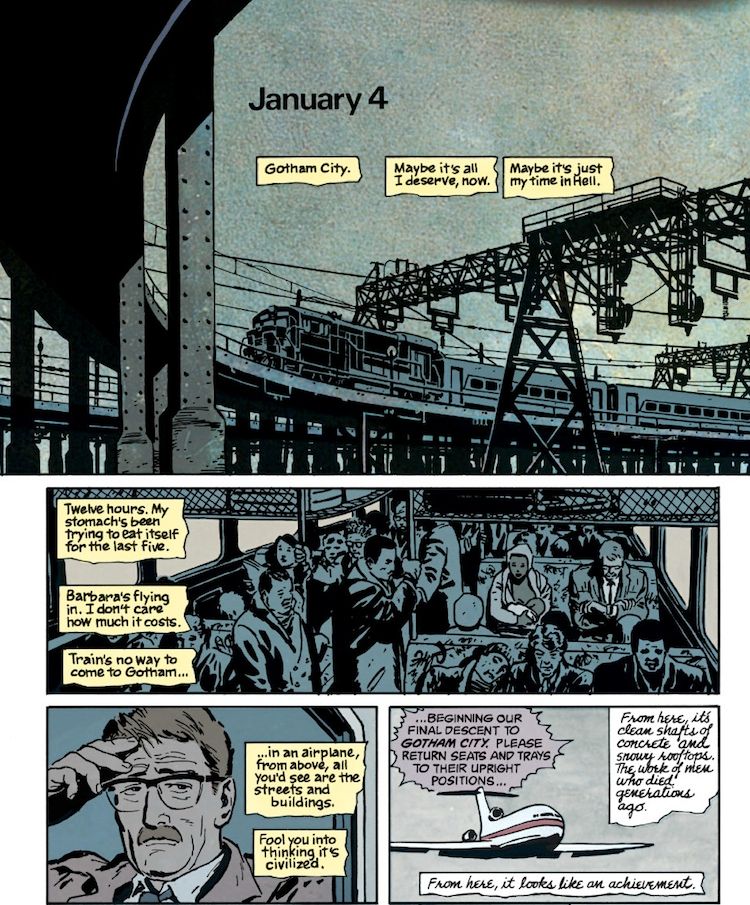
So does anyone else see any similarities there to B:YO? Because I sure as hell do, and I doubt that it's unintentional on Loeb and Sale's parts. This isn't the first time that Loeb referenced Frank Miller (that would be scene in Challengers of the Unknown where Rocky survives a race car crash and says, "It would be a good death," ala the first page of The Dark Knight Returns), but it is the first time that he drew from the well of Miller for a Batman story. Mind you, referencing Frank Miller isn't a bad thing if of itself (which comics creator HASN'T done that at one point or another?), but it's worth noticing that this is the first instance of a pattern that will become rampant to the point of Loeb lifting from Miller wholesale beyond mere homage.
We get a taste of that halfway through Madness, where a delusional, anguished, trashed, bleeding, and utterly exhausted Batman collapses into the arms of who he believes is Martha Wayne, but who is in reality his other mother figure, Leslie Thompkins, who then nurses him back to health. This moment seems highly reminiscent of a scene in Frank Miller and David Mazzucchelli's other mid-80's masterwork: Daredevil: Born Again, wherein a delusional, anguished, trashed, bleeding, and utterly exhausted Matt Murdock collapses in the arms of a nun--who really is his mother--who then nurses him back to health.
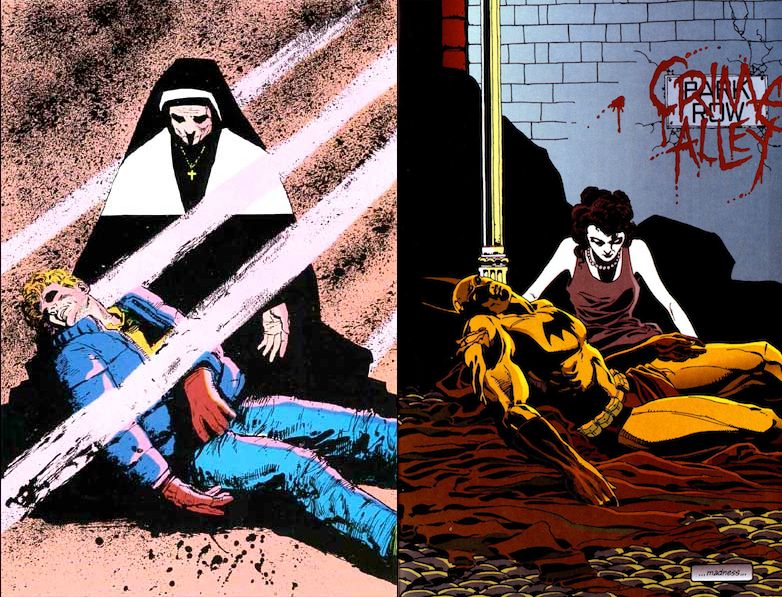
Also, I'm pretty sure that the Sale piece is a recreation of some famous painting or sculpture, but I don't know which. If so, then both writer and artist are lifting from two separate things, whee!
Again, there's nothing wrong with being inspired by Frank Miller, because let's face it, an entire generation of comics creators were (and are still) influenced by him, both consciously and subconsciously. However, as you will eventually see over the course of this Long Halloween review, I don't think that any single comics creator has so thoroughly strip-mined Miller's work for ideas, scenes, and characters quite so aggressively as Jeph Loeb. If nothing else, I think it's safe to assume that he was at least heavily borrowing narrative beats from Miller while he and Tim Sale were still in their formative stages of creating Batman tales.
But there's one writer who Jeph Loeb rips off more than Miller in Madness, and that's Jeph Loeb himself, as this story is pretty much a complete retread of Fears/Choices in much the same way that Dark Victory will be complete retread of The Long Halloween. Some of these events don't happen in the same order as in the other story, but the similarities occur nonetheless. Here, let's compare the first two Loeb/Sale Halloween specials, shall we? They both start off on Halloween, a night of family-friendly revelry that has been perverted into something dark and twisted.
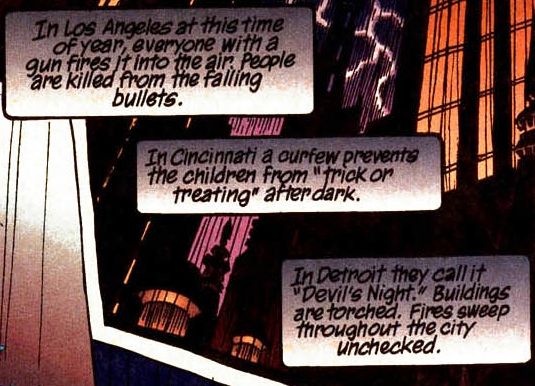
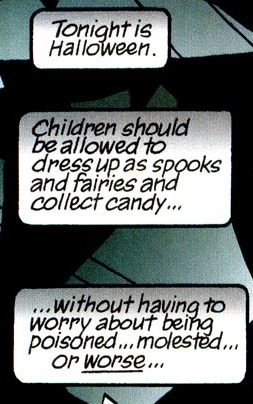
Batman chases after a villain who speaks almost entirely in quotes from children's literature.
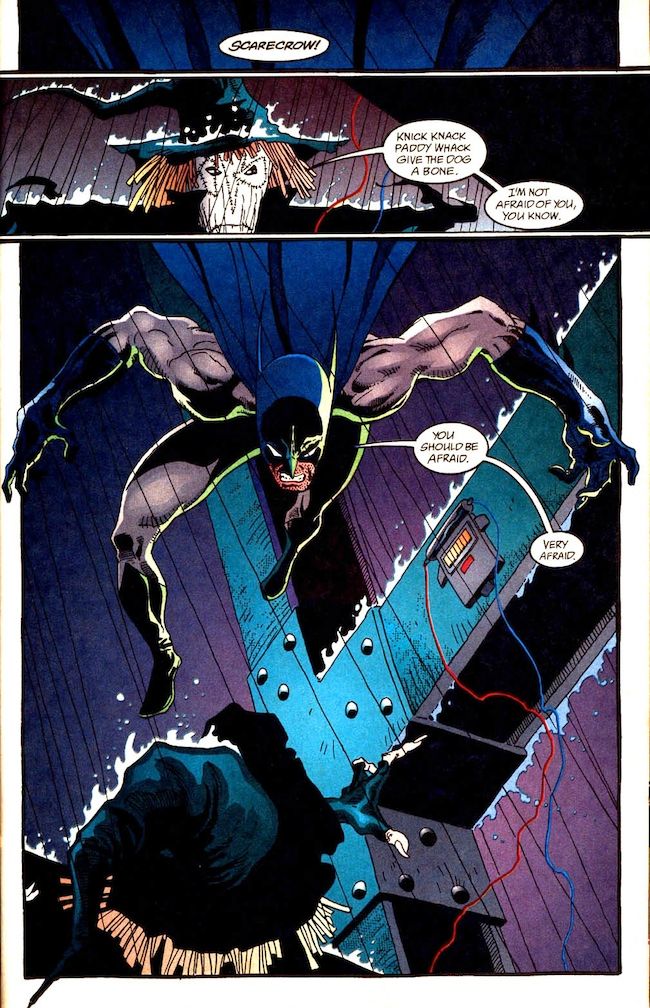
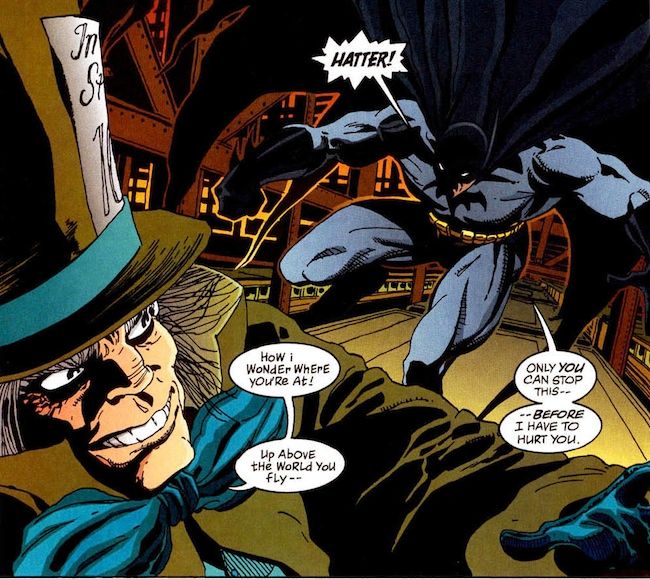
He tries reasoning with the villain, who continues to quote nonsensically.

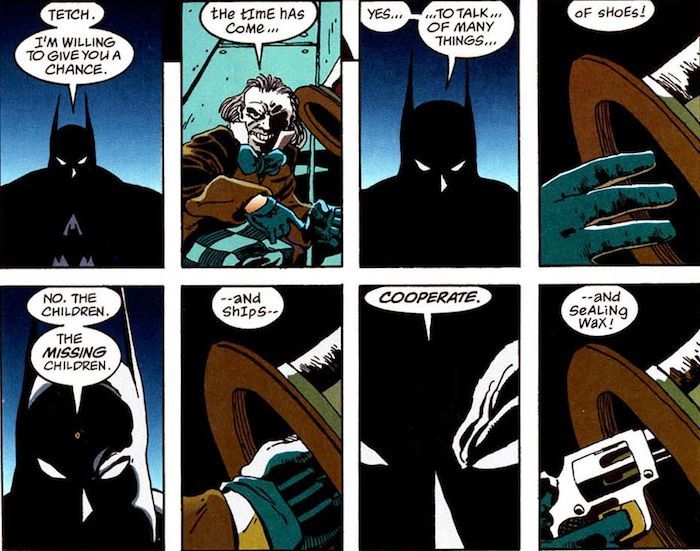
The quoting villain strikes back and Batman is critically injured.
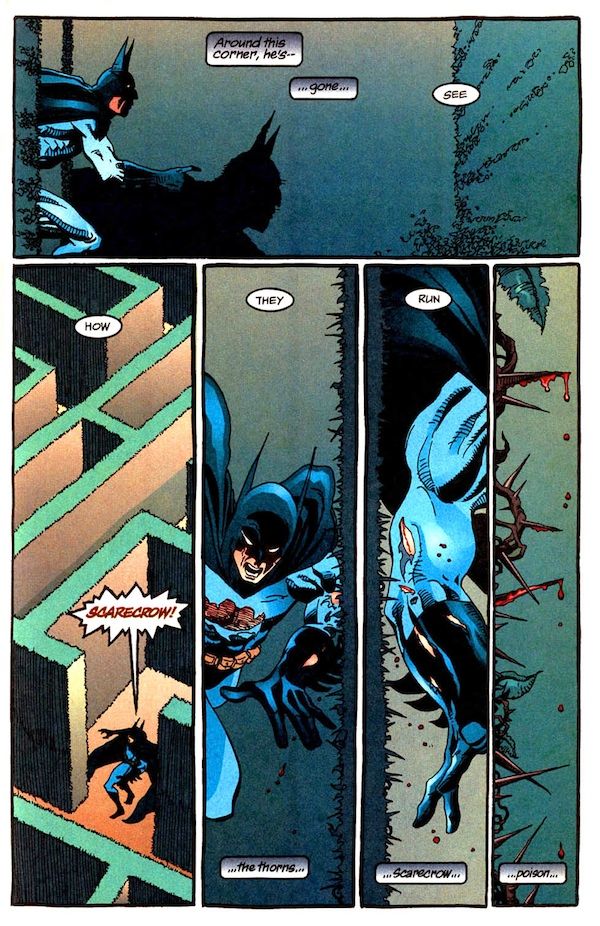
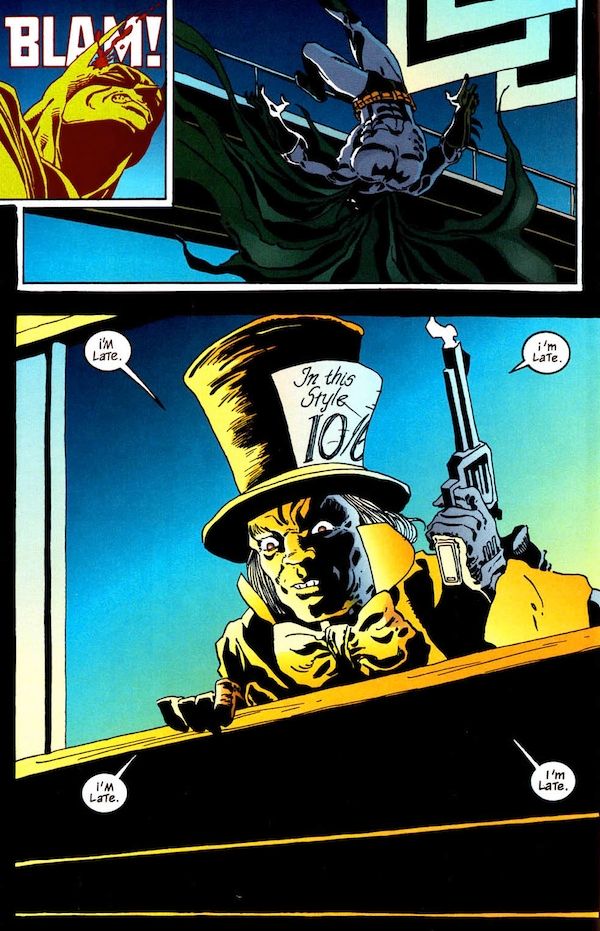
The injured and tormented Batman spirals into a hallucinogenic state.
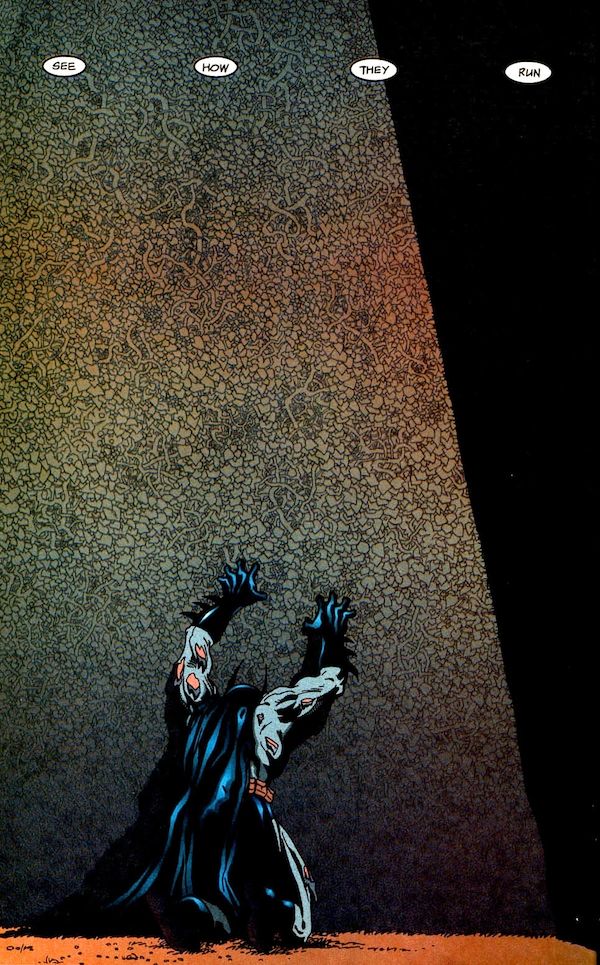
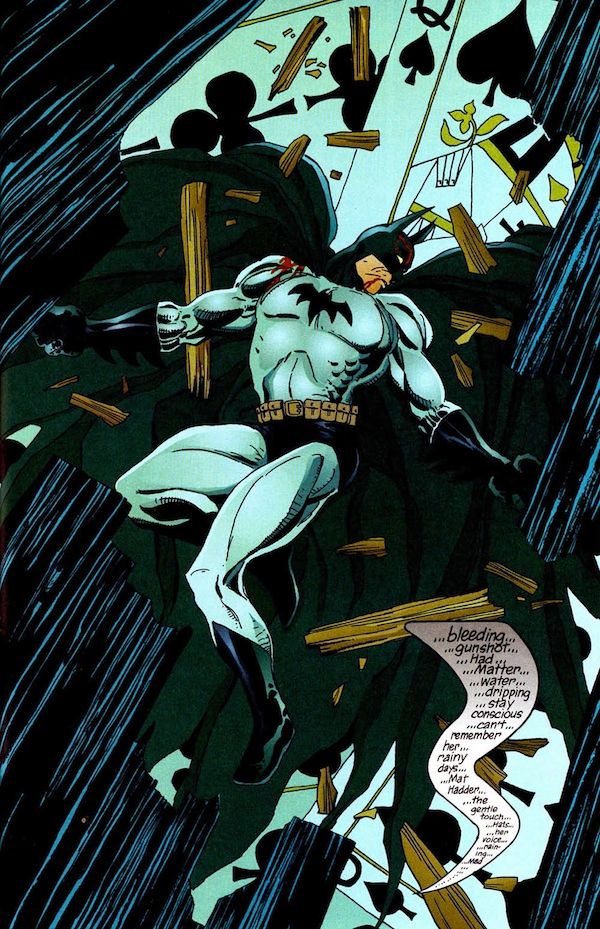
Then Batman hallucinates about his deepest, most private vulnerabilities.
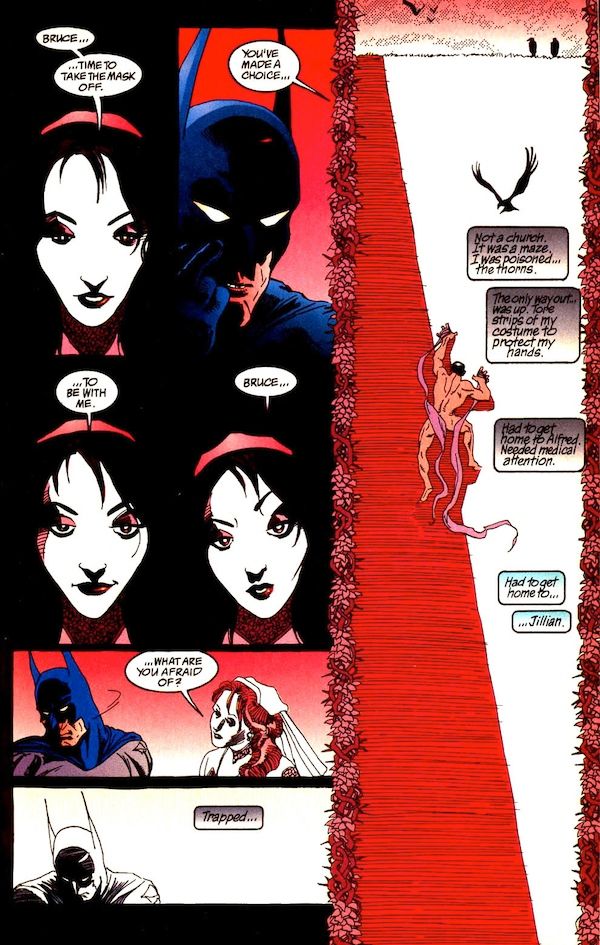
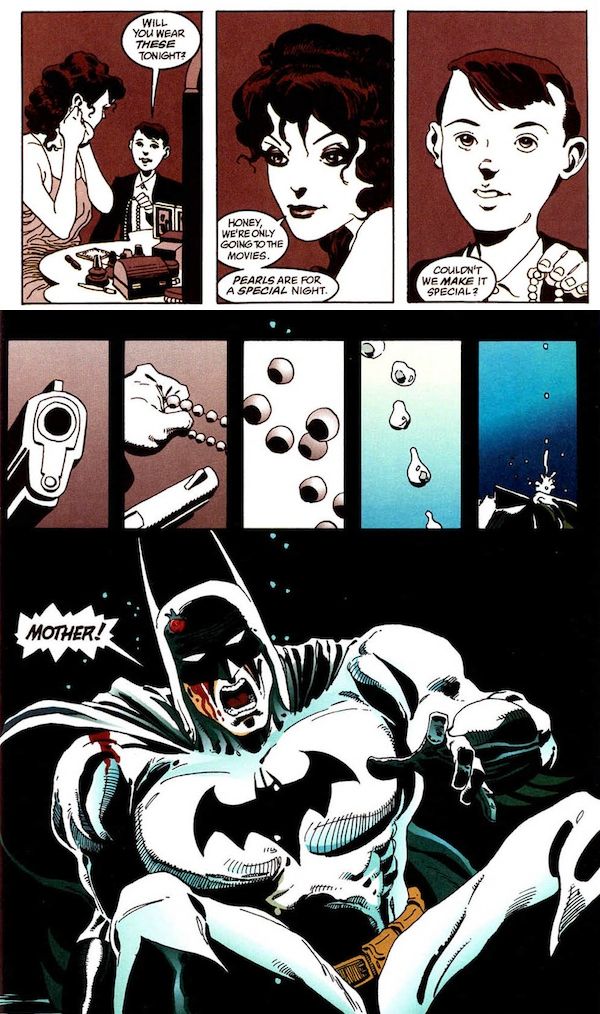
His life is saved by a parental figure who heals his wounds and rouses him back to consciousness.

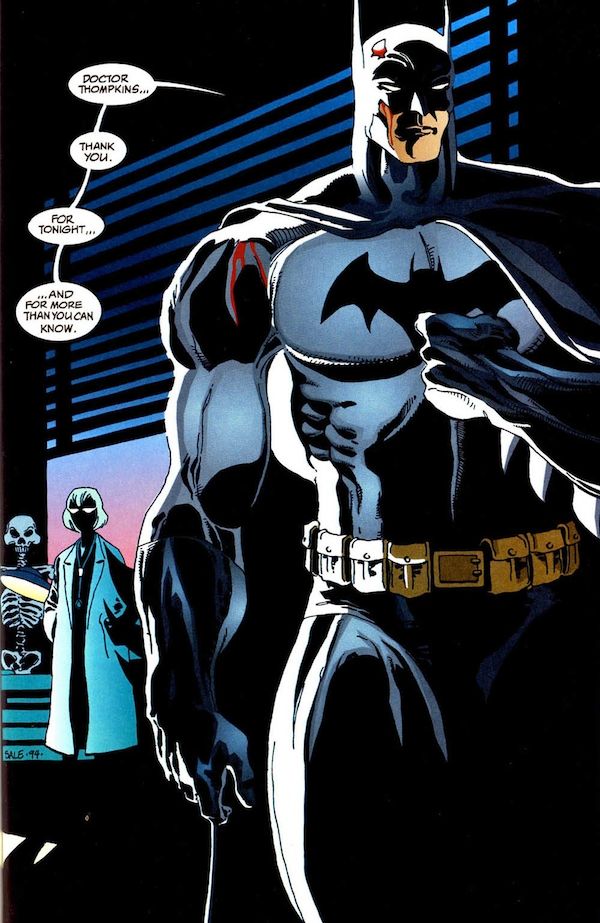
Meanwhile, the quoting villain kidnaps a Gordon.
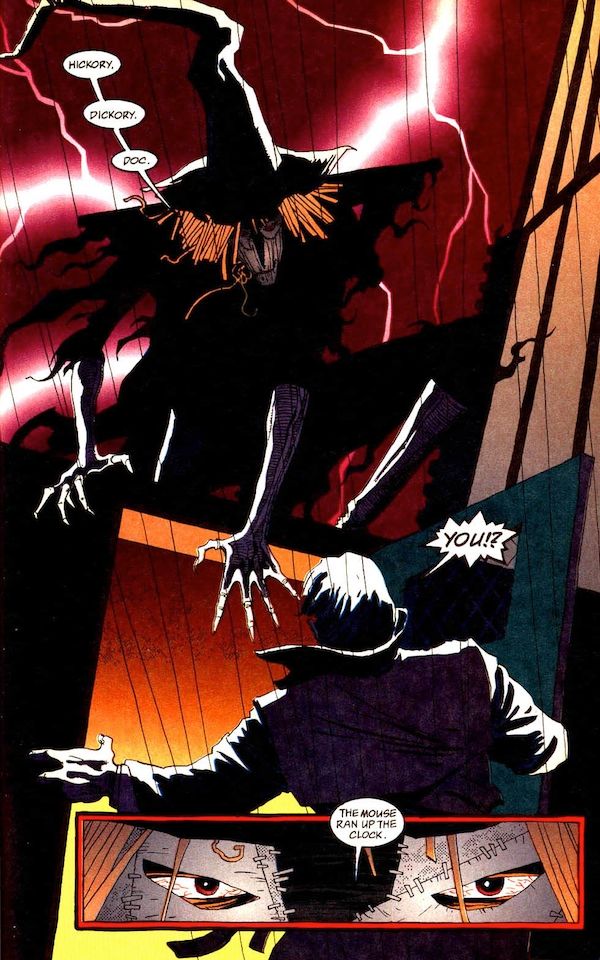
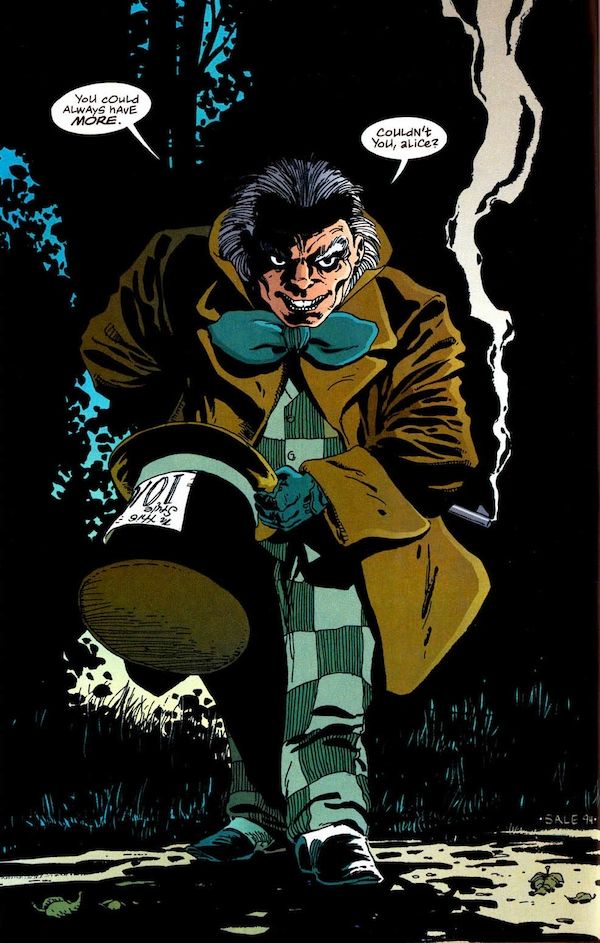
Jesus Christ, what in the name of all that's holy is going on with Batman's anatomy in the second image? Is this Tim Sale or Rob Liefeld?!
He then holds the Gordon hostage for no reason.
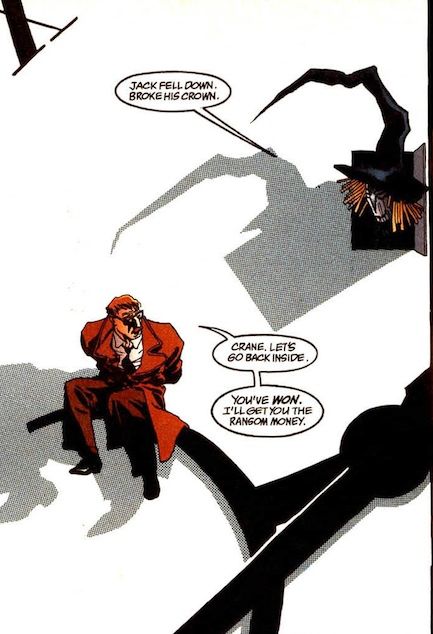
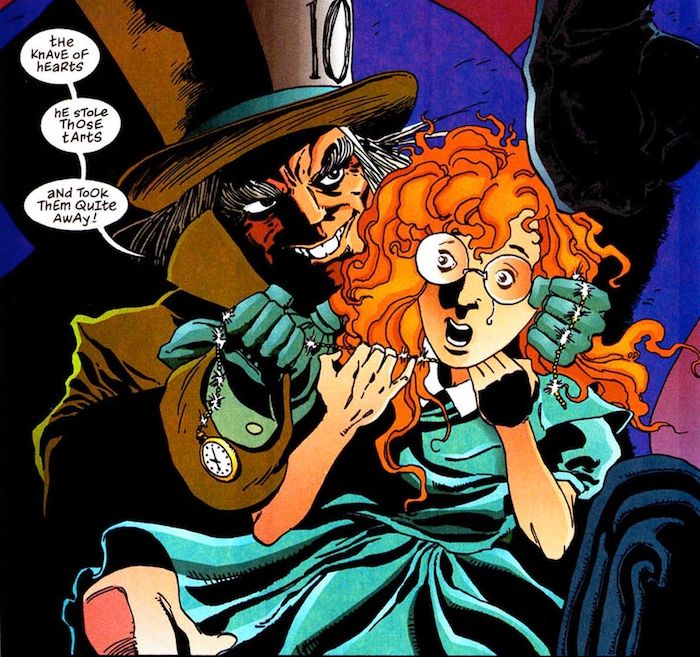
Batman confronts the quoting villain in a locale that has an infamous history involving dead children.
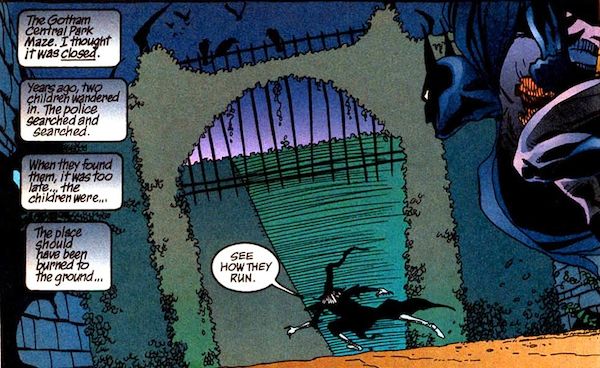

Fueled by hatred over how the villain has exploited that vulnerable, private place within Batman, our hero beats the crap out of the quoting villain.

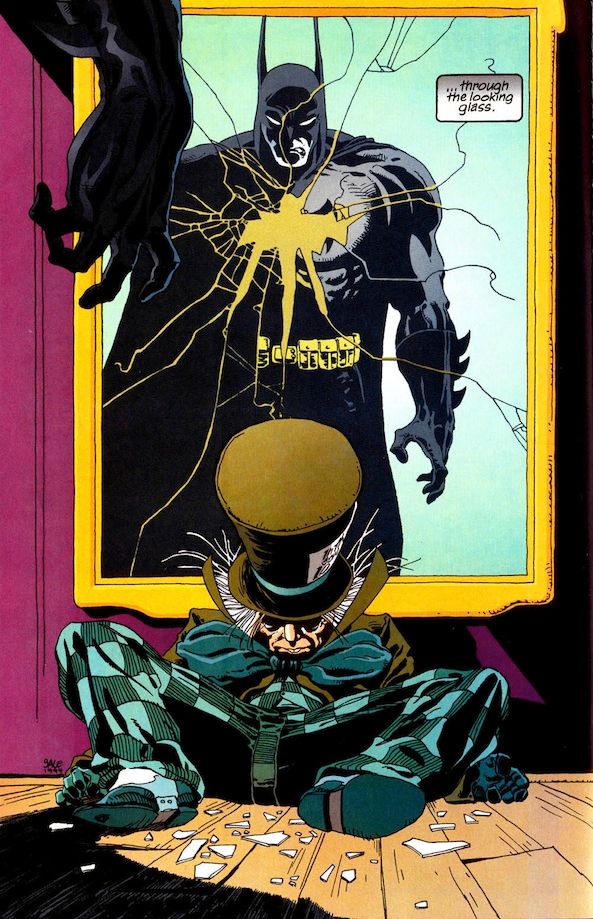
He then retreats to Wayne Manor, having come to terms with his issues this week.
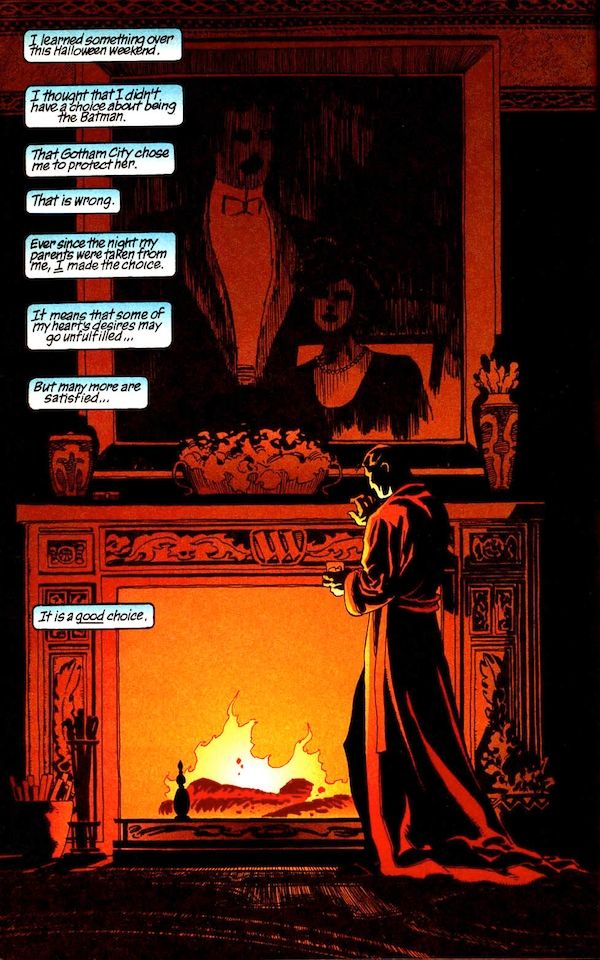
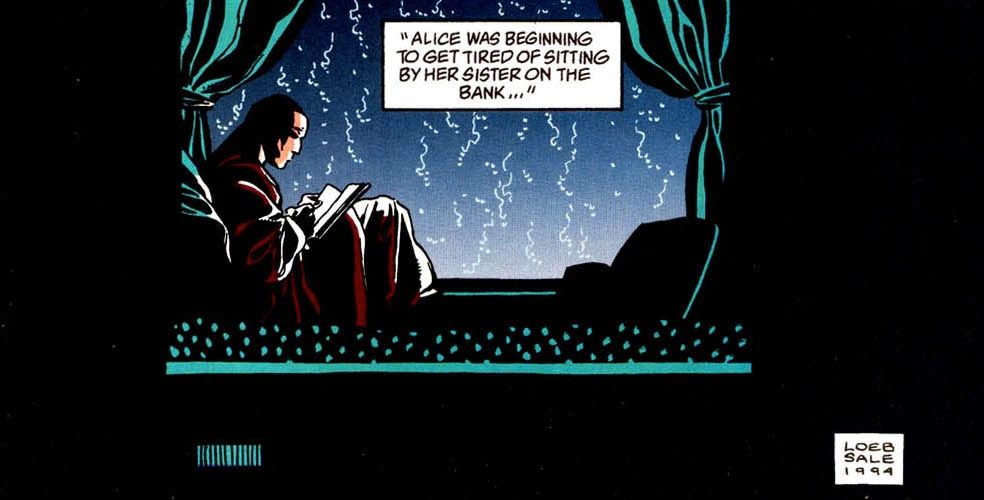
~FIN.~
From here, I was planning to mention some of the actual differences between these stories before delving into their third and final Halloween one-shot, but I'm afraid I must abruptly stop here. Why? Because my full post was too big for LJ to post! Geez, that's never happened to me before! Well, considering how lengthy this one was already, I'll just let this one be for the next day or two and post the rest of the prologue after we've had time to digest this along with our Thanksgiving leftovers.
EDIT: PART 2 IS UP!
So I reread these stories, and I dug around and found some interesting interviews with Loeb which shed some light on his creative process, and thus, in typical long-winded Hefner fashion, these "nods" and "quick overviews" exploded into an incredibly long prologue that deserved to be its own post. I think it's important to look at all five of these early collaborations between Loeb and Sale, with a special focus on Loeb himself and how he writes all these stories with similar (or repeating) themes, motifs, quirks, and bad habits, especially his tendency to reference or outright steal scenes from movies. These traits are all present within TLH, but I believe that they're less obvious when that book is read on its own, whereas they become glaring when compared with his earlier stuff which lay the foundation for TLH is more ways than I can count.

So join me as we examine not only the early collaborations between Loeb and Sale, but also look at Loeb's career and creative process from its humble beginnings way back, even earlier than you expect. Be warned: this post is a bit stream-of-consciousness, but I always manage to get back to the point. Well, almost always.
To get a clue about Loeb's process, we have to go back earlier than his first collaboration with Tim Sale, even before he became a successful Hollywood screenwriter and producer. In Mark Salisbury's 1999 book, Writers on Comics Scriptwriting, Loeb recounted his very first brush with the comics industry. In the early 1970's, back when he was about thirteen years old, a young Joseph Loebs III once wrote a Superman story to try and impress Elliot S! Maggin, one of the great Superman writers of all time. Loeb's story, entitled Why Must There Be a Superman, involved the Guardians of the Universe forcing Clark to account for the fact that his existence is meddling with the outcome of human history, although in Loeb's own words, "it eventually turned into--and I have to cop to this--the end of The Amazing Spider-Man #100." Loeb doesn't elaborate on what that entailed, but I hope it didn't involve a cliffhanger ending where Superman grew extra limbs.
Maggin's response to this story was less than glowing, as he recognized the lift from ASM#100. "I sent it to Elliot and he wrote me this long letter that basically said you can steal from movies, you can steal from books, you can steal from plays, but you can't steal from other comics. Don't do it again." Emphasis in bold is mine, because extra attention should be paid to that quote.
But wait, the story doesn't end there! Not long thereafter, Elliot S! Maggin wrote a story for Superman #247, one that would eventually go on to be considered one of the greatest Superman stories of all time, a tale that featured the Guardians of the Universe putting Superman on trial for crimes against humanity. Can you guess the title of this story?

Innnnnnnteresting, eh? Twenty years later, after Maggin had become Loeb's editor and mentor at DC Comics, they went to a comic shop together and found a copy of Superman #247, which is when Loeb casually called out Maggin for ripping off a story that he had condemned for being a rip-off in the first place. "It was like someone had dropped an anvil on his head [when I explained]. For the rest of the day, he just kept apologizing. Ultimately, Elliot's is a different story, because mine was Amazing Spider-Man #100. But I always found it odd that Elliot never mentioned it. So that was really the first comic I ever wrote. Elliot continues to apologize."
What I find interesting about this anecdote is that not only Loeb has been stealing from other stories since the very start of his comics career, but he learned first-hand from Maggin that theft is encouraged and commonplace. This certainly would explain a great deal about how liberally Loeb would "borrow" from other stories throughout his career, not just in Batman: The Long Halloween but all throughout his career as a comic writer who--unlike with "the first comic" he ever wrote--actually gets credited for his own work. Before that happened, though, Loeb realized early on that it's darn near impossible to make a living as a comic writer, so instead he became a Hollywood screenwriter in the 1980's, during which he co-wrote the scripts for four major motion pictures: Teen Wolf with Michael J. Fox, Commando with Arnold Schwarzenegger, Burglar with Whoopi Goldberg, and Teen Wolf Too with Jason Bateman.
You'll note that none of these films are notable for being especially good, but Commando--which Loeb only co-plotted but didn't script--is at least awesomely stupid, and thoroughly entertaining in a very McBain kind of way. So how the heck did Loeb end up writing for comics? The same way anyone gets ahead in both Hollywood and mainstream comics alike: it's all about who you know. A colleague of his who was directing a Superman documentary for TV knew that Loeb was a fanboy and got his pal in touch with DC Comics president Jenette Kahn. Originally, they were going to make a movie of The Flash (it'd be interesting to know how that might have turned out), but when that deal fell through, it looked as though Loeb's association with DC was going to end right then and there. Or it would have, if the Jenette Kahn didn't say, "If you're not going to write a movie for us, would you like to write a comic book?"

"... KAAAAAAAAHHHHHHHHHNNNNN!!!"
Faced with the prospect of "a dream come true" to write comics for DC, Loeb's mind reeled at the thought of all the stories he wanted to write. In the introduction that accompanied his first published issue, Loeb wrote, "At last, I could get a crack at writing Batman. Or maybe I'd do Superman. Or maybe I'd team up and have them fight Wonder Woman." That last one gives me pause, as I'm not sure if he wanted to have Superman and Batman beat up Wonder Woman together or if he wanted to show how Wonder Woman could kick both Bruce and Clark's combined asses. In any case, I find that interesting considering that Loeb would go on to great success with both Batman and Superman while never writing Wonder Woman in any greater capacity than a supporting role. Hrm.
Unfortunately for Loeb, he wasn't allowed to use either of his two favorites just yet. Working with DC's vice president and executive editor Dick Giordano (who was also probably the greatest Batman inker of all time), Loeb was instead handed a list of available C-list properties, eventually settling on "Challengers of the Unknown, which I didn't really know." A classic Silver Age DC team created by the King himself, Jack Kirby, the Challengers were an adventure-seeking "fantastic foursome" who predated a similar, far more famous Kirby-co-created team by a few years, and Loeb wanted to figure out how to "bring them into the nineties." Oh dear. I dunno about you, but that's an ominously Hollywood-producer-type ambition if ever I've heard one.


The Challengers' profile Who's Who in the DC Universe #1 (August 1990), written and drawn by the new creative team in anticipation of the series.
When Loeb's editor, Barbara Randall (AKA Barbara Kesel) asked him about potential artists for CotU, Loeb said that he wanted "somebody who can draw guys that look different," and that "The last thing I wanted for the book was to have four men who essentially looked like Bruce Wayne, but with different colored hair." Oddly, Loeb's dream artists to pull this off were "Jim Lee, Whilce Portacio, and Rob Liefeld," none of whom exactly come to mind in terms of making their characters look distinct. As all three were thankfully under contract at Marvel, Randall came up with a very different suggestion: an up-and-comic artist named Tim Sale, who had worked on the indie fantasy anthology Thieves World, plus an issue of Batman where he inked Norm Breyfogle.

I honestly can't tell where the Breyfogle ends and the Sale begins.
Sale was one of those artists who brought a oddball, post-underground-comix sensibility to his work in keeping with other artists of the time, people like Kyle Baker, Marc Hempel, and Matt Wagner (all of whom contributed covers to Loeb and Sale's Challengers of the Unknown, incidentally), as well as Mark Badger, Bernie Mireault, John K. Snyder III, and more. With an art style that resembled a mix between Wagner and Cerebus' Dave Sim, Sale's work was an instant winner with Loeb, who loved how Sale "drew really ugly people," and that "his people looked different. They had hook noses and long necks and some were fat."
Despite this admiration, the partnership between Loeb and Sale was rocky at the start, with Loeb constantly telling Sale to redraw pages to the point where, as Loeb recounted, "We took about a year, and Tim drew probably forty pages for a twenty-two page story before we turned anything in to DC." Eventually, of course, the two clicked and produced a Challengers of the Unknown unlike any other than came before or after. Much like Andrew Helfer's batshit insane run on The Shadow and Grant Morrison's Doom Patrol, this take on CotU was a rather--to put it lightly--irreverent spin on the source material, with the classic characters quickly turning into bizarre, twisted, modern-day versions of themselves. By the time Loeb and Sale were through and the "Challs" received an updated Who's Who entry in February 1992, they were barely recognizable as themselves.


Man, it just screams "EXTREME FOR THE 90'S" doesn't it? To Loeb and Sale's credit, the story is one of their most intriguingly oddball and original works, to the point that it might honestly be their best--or at least, more unique--collaboration, and it wins extra points for featuring the all-star gallery of awesome cover artists. Regardless, it failed to revitalize the team for the modern era, and while the final issue of CotU promised a sequel in the works with Giordano's involvement, those plans were eventually scrapped--I've no idea why--and all subsequent iterations of the CotU apparently ignored Loeb and Sale's take.
This might have spelled the end of Jeph Loeb's comics career, not to mention his partnership with Tim Sale, if it weren't for the intervention of Archie Goodwin, who succeeded Andrew Helfer as editor on Legends of the Dark Knight. I've written in the past about how I thought LotDK went downhill in quality after Helfer's departure, as I feel like the stories under Goodwin were still moody and atmospheric with great art, but the stories themselves weren't as solid as they were under Helfer. As such, Goodwin always struck me as a guy with an eye towards the art aspect of comics over the writing one, but I'm no expert on Goodwin's work, so I could be wrong on that count. What I do know is that Goodwin had a reputation for being the most gosh-darn nice person who ever worked in comics, that he was beloved by everyone, and considering that editors at DC today are such assholes that they're driving away creators in droves, I think everyone could stand to be more like the late Mr. Goodwin.
After bringing Sale onto LotDK with the dark Cavalier story Blades (written by James Robinson), Goodwin discovered that the artist had a knack for drawing both Batman and the landscape of Gotham City, and so, in 1993, he reunited the artist with Loeb to create a story which would change the course of their entire comics career.

Though he'd originally intended it to be a three-part LotDK story like Blades (and it still reads that way), Loeb was the one who suggested turning the story into a standalone Halloween special. In his introduction for the collected edition of Loeb and Sale's Haunted Knight trilogy (as they came to be known), Goodwin wrote, "Like most great ideas, it seemed simple, obvious, and natural. Amazingly, given Batman's 'creature of the night' persona, no one in recent memory had tried anything quite like it." Strangely, the final story itself actually had very little to do with Halloween besides the fact there's a costume party at Wayne Manor in a scene which looks and feels very reminiscent of an early scene from Matt Wagner's own LotDK story, Faces, and beyond that, there's nothing involving Halloween except... well, it's got the Scarecrow in it, so that counts, somehow?
The title of the special was originally Choices, but it was later changed to punchier Fears by the time it was collected in Batman: Haunted Knight. Though ostensibly a story of Batman facing down the Scarecrow with all the usual beats (Crane terrorizes the city, Batman gets drugged, Batman overcomes it, Batman punches the Scarecrow in the face, yay justice), the heart of the plot involved Bruce finding love with a mysterious woman, who tempts him to hang up his cape and cowl and marry her. So yeah, when the story isn't going through the usual Scarecrow motions, it's focused on the hoary cliche of "superhero finds love, considers giving it up for a normal life, doesn't because of reasons." Obviously, that doesn't work out, and while I won't spoil the not-entirely-surprising twist, I will say that it gives Loeb an opportunity to lift from the ending of the 1981 film Body Heat in the story's final page.

Is this a case of Loeb taking Maggin's "you can steal from movies" to heart, or it just a simple homage? That's a question you'll want to keep in mind, as we'll be asking it a LOT from here on out.
All in all, both plotlines of Fears/Choices are as thin as the paper they're printed on, and that's not even to go into Loeb's use of dialogue and narration, although we will be getting into those in the reviews of TLH. As will be the case for all of the collaborations between Jeph Loeb and Tim Sale, I strongly suspect that the story would have fallen apart without Sale's artwork holding it together. If it's unfair to outright call Sale the true power behind this team, then at the very least, Loeb's greatest skill has been knowing how to utilize Sale's strenghts for maximum impact. I'm tempted to call Sale's work "unlike anything we've ever seen before," when in fact it shares similar characteristics of artists like David Mazzucchelli and Matt Wagner, all whipped up into a style which helped make Fears/Choices a hit and secure a sequel for him and Loeb.
Aside from Sale's storytelling, the most remarkable thing about Fears/Choices is their take on the Scarecrow, which was a wildly different take on the character both in terms of writing and design, the latter of which seems to be directly based on an obscure old Disney show called The Scarecrow of Romney Marsh, also known as Alias, the Scarecrow, which starred The Prisoner's Patrick MacGoohan. Sale's Scarecrow design also added other touches for creepiness' sake, such giving Crane freaky long fingernails for some reason, and a crooked hat that would fit right in with a Tim Burton movie.


Some fan even went full circle and commissioned a Dr. Syn Scarecrow piece by Sale!
But by far, the weirdest change was Loeb's decision to have the Scarecrow speak almost entirely in lines from nursery rhymes. Why? The Scarecrow has never had any history with nursery rhymes, nor does he have any reason to quote them within the context of the story. I can only suppose that Loeb did this because it's intended to be creepy, regardless of whether or not it makes sense. Now, in one panel, he also quotes the Scarecrow from The Wizard of Oz ("That way is a very nice way. It's pleasant down this way, too. Of course, people do go both ways," he says at one point for no reason), but that's at least marginally relevant to the character, unlike all the goddamn nursery rhymes. This will be far from the last time that Loeb puts mood and atmosphere over plot and consistent characterization.
That said, perhaps the "consistent characterization" part doesn't matter, considering that Legends of the Dark Knight existed in a strange area where the rules of continuity didn't really apply, here's where things start to get kinda murky. If you'll allow me to tangent for a bit, I think it's worth pointing out that the introduction to the first issue of LotDK touted that the new series was intended for creators "to tell stories that stand alone, outside the regular continuity of Batman and Detective Comics." Furthermore, in his intro to Haunted Knight, Archie Goodwin described the gist of LotDK as follows: "Set in the early years of Batman's career, Legends of the Dark Knight story arcs function like self-contained novels or novelettes without the ongoing continuity associated with most comics today."
Does this mean that the stories of LotDK--including Loeb and Sale's, all the way up through The Long Halloween--were intended out of continuity? I certainly took it that way, especially once I saw that Wizard Magazine said that TLH "isn't regarded as true continuity" because it was published under the LotDK banner. On the other hand, a couple of the original LotDK stories were later written into proper ongoing continuity, but both of those stories--Shaman and Venom--were written by Denny O'Neil, who was also group editor of the Batman books, so he's allowed the bend the rules in ways that other writers aren't.
My Henchgirl has guideline for continuity: it's not canon unless the events have been reaffirmed or referenced by at least one other writer. By that rule, Venom is in canon because it was referenced by Doug Moench in Knightfall, but Shaman is not, because the only writer who gave a shit about Shaman was O'Neil himself. Furthermore, LotDK featured other unique takes on Batman characters--including the Cavalier, Catman, the Spook, and Hugo Strange--which weren't reflected in regular continuity, unless/until someone decided to come along later and acknowledge the LotDK version, as Devin Grayson did with Hugo a decade after Prey came out. Goddammit, DC, what do you pay your editors for?! Argh!
As such, I think Loeb and Sale's stories--like all of LotDK--aren't strictly "out of continuity" as much as they are, as Wizard put it, "not true continuity." Basically, they're out of continuity until stated otherwise, and even then, preferably written by some source other than the writer who wrote it in the first place. For example, The Long Halloween and Dark Victory were originally out of continuity because no other stories referenced those events until Batman: Hush in 2003, but that still doesn't really count because it was written by Jeph Loeb. It wasn't until 2009 with Batman #692 that it was finally referenced in a mainstream Batman comic, thus making it canon. Thanks, Tony Daniel! *gold star*
With all that in mind, the Scarecrow's bizarre appearance and propensity for speaking in nursery rhymes can arguably be excused here and enjoyed on its own merits (such as they are) with the understanding that this is purely Loeb and Sale's take, existing within their own sub-universe of Batman stories. In any case, the Scarecrow is a popular and iconic enough character that Loeb and Sale's take--while relatively popular, it seems--hasn't greatly affected the character anywhere else, aside from influencing a line of dialogue in Batman Begins. Whether you love or hate "Salecrow," it hasn't affected the character as a whole. The same, however, cannot be said of the Mad Hatter, who was the star of Loeb and Sale's second LotDK Halloween special, which came out in 1994.

There's a lot to discuss when it comes to Madness beyond its beat-by-beat copycat plotline of Fears/Choices, not the least of which being how it was instrumental in helping to make Jervis Tetch a toxic, unusable character in comics and other media. Of course, we can't put all the blame on Loeb and Sale, because if there's one single creator who's done more damage to Jervis Tetch than anyone else, it's Grant Morrison. In Arkham Asylum: A Serious House on Serious Earth, Morrison redefined the classic C-list Batman villain by writing him in such a way that strongly implied tendencies towards pedophilia, a meta reference to the controversy about Lewis Carroll's own possible pedophilia. Now, this in of itself wasn't so harmful to Jervis, as Arkham Asylum was itself a story very much in the same LotDK vein of being "not true continuity," and sure enough, no hints of pedophilia were included in the Hatter's subsequent appearance in Knightfall, where Doug Moench wrote Jervis the same way that he wrote the character in the 80's.

More importantly, a few months before that issue of Knightfall came out, the Mad Hatter had already been reinvented in Batman: The Animated Series, which remains the very best version of the character. Delightful and disturbing, skeezy yet sympathetic, and perfectly voiced by Roddy McDowall, the TAS Hatter had a personality, motivation, and a distinct appearance that made him unique and recognizable rather than mere evil version of Sir John Tenniel's iconic illustration, which is how the character originally appeared in his Golden Age first appearance. The TAS version by Paul Dini turned the C-list villain into one of the richest rogues in Batman's gallery, leaving it to comics to embrace this take on the Hatter just as they did (or tried to do) with Mister Freeze.

Of course, that never happened, and I think we have Loeb and Sale to blame for that, as their version of the Mad Hatter has proven to be the most influential for the character in comics, games, and animation alike, in terms of both physical appearance and in his motivations as a character. In Madness--and I'll talk about the story as a whole soon after I rant a bit first--the Mad Hatter not only now physically resembled the Tenniel drawing again, but he also took Morrison's implications of pedophilia and put them into practice by having their Hatter kidnap runaway children and keep them in his hideout, where he forces them to drink drugged tea and dress in Wonderland costumes.

Is it even worth mentioning that this is a recreation of the classic Mad Tea Party scene by Tenniel? Everyone knows that, right? Does that make this clever or just obvious?
Sure, no sexual interest in the children is ever mentioned in Loeb's story, but considering that the Hatter never went after kids before, it's hard not to feel skeezed out by the implications of kidnapping and drugging children for one's own pleasure. Especially considering that Madness doesn't give any reason WHY Jervis is kidnapping children, leaving it entirely to us readers to figure out why. Now, I suppose there's the possibility that there really isn't anything sexual about this, and that maybe he just wants them to live out an eternal childish fantasy at gunpoint, or heck, maybe he could have been giving these runaways sanctuary and protection like Poison Ivy did in No Man's Land. That would have been a great idea, actually!
But no, considering that his hideout in an old mansion where a child was murdered by kidnappers, not to mention the fact that he was gleefully ready to strange a teenage girl at one point, I think it's safe to assume that the subtext, at least, goes back to Morrison's disturbing implications. To make matters worse, Jeph Loeb's Mad Hatter had no personality to go with his lack of motivations, reducing him to a cipher who--you guessed it--speaks only in quotes. Well, at least it's appropriate for the Mad Hatter to speak in Lewis Carroll quotes, so I guess that sorta makes up for him being a poorly-written non-character whose pedophiliac subtext pretty much ruined the character forever.
Ever since Madness, the Mad Hatter has not only physically remained a dwarf who often shares similar costume characteristics to Sale's design (something which even TAS adapted in their redesign of the character for The New Batman Adventures, right down to Madness' color scheme and the fact that he's much older than TAS Jervis), but he's almost always been depicted as a child-like pervert who has been shown to do things like mind-controlling young girls so he could sell them as sex slaves to pedophile diplomat and fuck hats in his free time. His most famous appearance in the past decade has been in a pair of video games where he's explicitly depicted as "a rapist and murderer" who brainwashed women into being his "Alice" and then killing them afterwards. All this can arguably be traced to Jeph Loeb and Tim Sale as much as Grant Morrison himself, which makes it hard for me to try and enjoy Madness on its own merits. Whatever those merits may be. Let's examine it, shall we?

The Gordon Family: James, Barbara, Barbara, and James. Comic writers are an imaginative bunch, aren't they?
While Fears/Choices took place in a nebulous "Year One"-ish period, Madness is set a bit later on in Batman's career. Or maybe earlier. It's hard to tell. James Gordon Jr. was born near the end of Batman: Year One, and he looks about six months old in Madness, although Jim Sr. is shown insisting that "he's not a baby anymore" while trying to get him weaned off bottles, so he could just be a really tiny two-year-old, which could set this in as late as Batman's Year Three period.

Also, teenage Barbara Gordon is living with James and his wife, also named Barbara, because this is the set in the Post-Crisis period where--in an excellent new origin written by Loeb's CotU editor, Barbara Randall--Babs is Jim's niece whom he adopted after her father, Jim's brother, died of alcohol abuse. Also, Batman mentions Two-Face, so this has to be set after TLH, unless Loeb and Sale didn't bother trying to keep their own continuity straight... you know what, screw it. Let's just accept that it's "not true continuity" and go on from there. We're introduced to Babs--who, as depicted by Sale, has Hermione hair--in a page that strongly resembles the first page of Frank Miller and David Mazzucchelli's Batman: Year One, where we were introduced to Jim Gordon.

So does anyone else see any similarities there to B:YO? Because I sure as hell do, and I doubt that it's unintentional on Loeb and Sale's parts. This isn't the first time that Loeb referenced Frank Miller (that would be scene in Challengers of the Unknown where Rocky survives a race car crash and says, "It would be a good death," ala the first page of The Dark Knight Returns), but it is the first time that he drew from the well of Miller for a Batman story. Mind you, referencing Frank Miller isn't a bad thing if of itself (which comics creator HASN'T done that at one point or another?), but it's worth noticing that this is the first instance of a pattern that will become rampant to the point of Loeb lifting from Miller wholesale beyond mere homage.
We get a taste of that halfway through Madness, where a delusional, anguished, trashed, bleeding, and utterly exhausted Batman collapses into the arms of who he believes is Martha Wayne, but who is in reality his other mother figure, Leslie Thompkins, who then nurses him back to health. This moment seems highly reminiscent of a scene in Frank Miller and David Mazzucchelli's other mid-80's masterwork: Daredevil: Born Again, wherein a delusional, anguished, trashed, bleeding, and utterly exhausted Matt Murdock collapses in the arms of a nun--who really is his mother--who then nurses him back to health.

Also, I'm pretty sure that the Sale piece is a recreation of some famous painting or sculpture, but I don't know which. If so, then both writer and artist are lifting from two separate things, whee!
Again, there's nothing wrong with being inspired by Frank Miller, because let's face it, an entire generation of comics creators were (and are still) influenced by him, both consciously and subconsciously. However, as you will eventually see over the course of this Long Halloween review, I don't think that any single comics creator has so thoroughly strip-mined Miller's work for ideas, scenes, and characters quite so aggressively as Jeph Loeb. If nothing else, I think it's safe to assume that he was at least heavily borrowing narrative beats from Miller while he and Tim Sale were still in their formative stages of creating Batman tales.
But there's one writer who Jeph Loeb rips off more than Miller in Madness, and that's Jeph Loeb himself, as this story is pretty much a complete retread of Fears/Choices in much the same way that Dark Victory will be complete retread of The Long Halloween. Some of these events don't happen in the same order as in the other story, but the similarities occur nonetheless. Here, let's compare the first two Loeb/Sale Halloween specials, shall we? They both start off on Halloween, a night of family-friendly revelry that has been perverted into something dark and twisted.


Batman chases after a villain who speaks almost entirely in quotes from children's literature.


He tries reasoning with the villain, who continues to quote nonsensically.


The quoting villain strikes back and Batman is critically injured.


The injured and tormented Batman spirals into a hallucinogenic state.


Then Batman hallucinates about his deepest, most private vulnerabilities.


His life is saved by a parental figure who heals his wounds and rouses him back to consciousness.


Meanwhile, the quoting villain kidnaps a Gordon.


Jesus Christ, what in the name of all that's holy is going on with Batman's anatomy in the second image? Is this Tim Sale or Rob Liefeld?!
He then holds the Gordon hostage for no reason.


Batman confronts the quoting villain in a locale that has an infamous history involving dead children.


Fueled by hatred over how the villain has exploited that vulnerable, private place within Batman, our hero beats the crap out of the quoting villain.


He then retreats to Wayne Manor, having come to terms with his issues this week.


~FIN.~
From here, I was planning to mention some of the actual differences between these stories before delving into their third and final Halloween one-shot, but I'm afraid I must abruptly stop here. Why? Because my full post was too big for LJ to post! Geez, that's never happened to me before! Well, considering how lengthy this one was already, I'll just let this one be for the next day or two and post the rest of the prologue after we've had time to digest this along with our Thanksgiving leftovers.
EDIT: PART 2 IS UP!